Abstract
A variety of pathogenic bacteria produce phospholipases C, and since the discovery in 1944 that a bacterial toxin (Clostridium perfringens alpha-toxin) possessed an enzymatic activity, there has been considerable interest in this class of proteins. Initial speculation that all phospholipases C would have lethal properties has not been substantiated. Most of the characterized enzymes fall into one of four groups of structurally related proteins: the zinc-metallophospholipases C, the sphingomyelinases, the phosphatidylinositol-hydrolyzing enzymes, and the pseudomonad phospholipases C. The zinc-metallophospholipases C have been most intensively studied, and lethal toxins within this group possess an additional domain. The toxic phospholipases C can interact with eukaryotic cell membranes and hydrolyze phosphatidylcholine and sphingomyelin, leading to cell lysis. However, measurement of the cytolytic potential or lethality of phospholipases C may not accurately indicate their roles in the pathogenesis of disease. Subcytolytic concentrations of phospholipase C can perturb host cells by activating the arachidonic acid cascade or protein kinase C. Nonlethal phospholipases C, such as the Listeria monocytogenes PLC-A, appear to enhance the release of the organism from the host cell phagosome. Since some phospholipases C play important roles in the pathogenesis of disease, they could form components of vaccines. A greater understanding of the modes of action and structure-function relationships of phospholipases C will facilitate the interpretation of studies in which these enzymes are used as membrane probes and will enhance the use of these proteins as models for eukaryotic phospholipases C.
Full text
PDF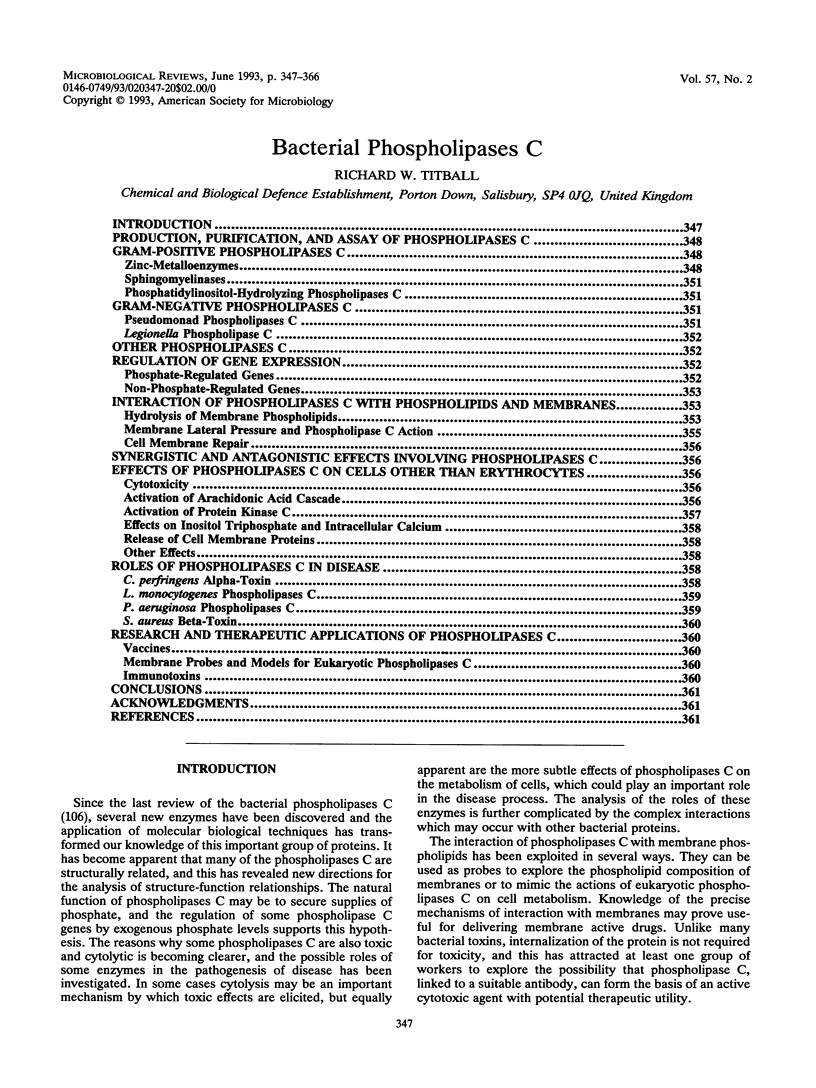
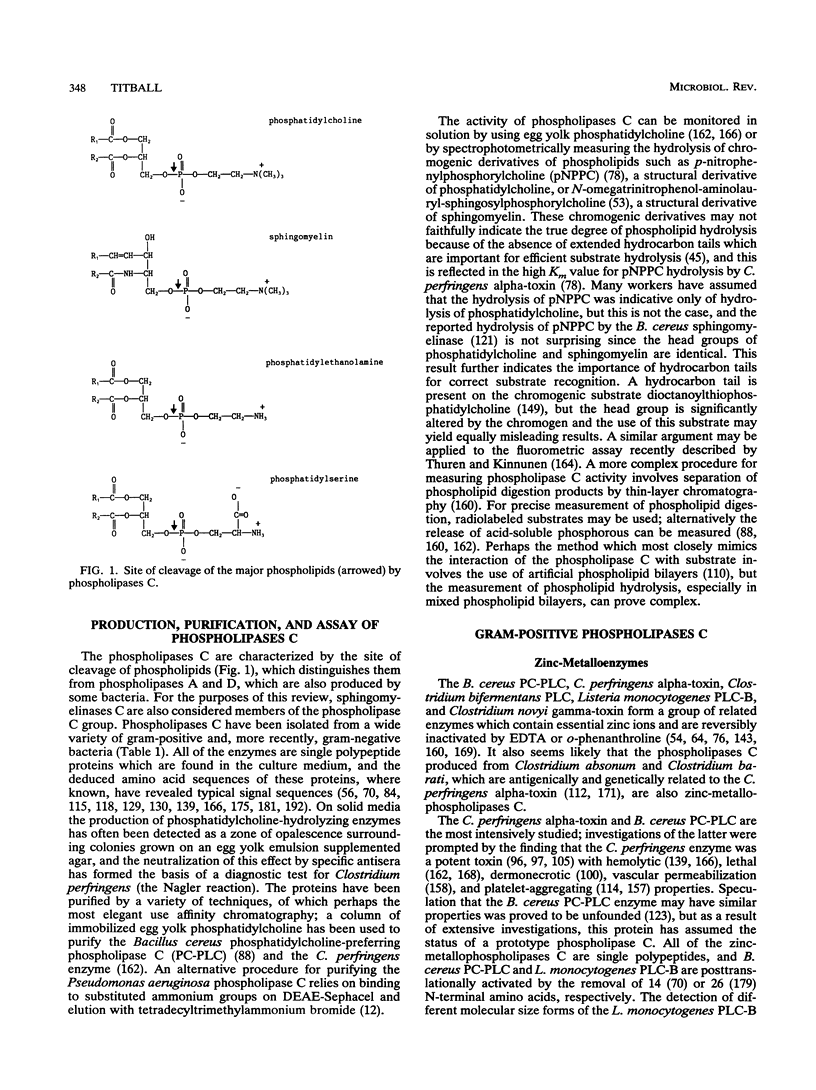
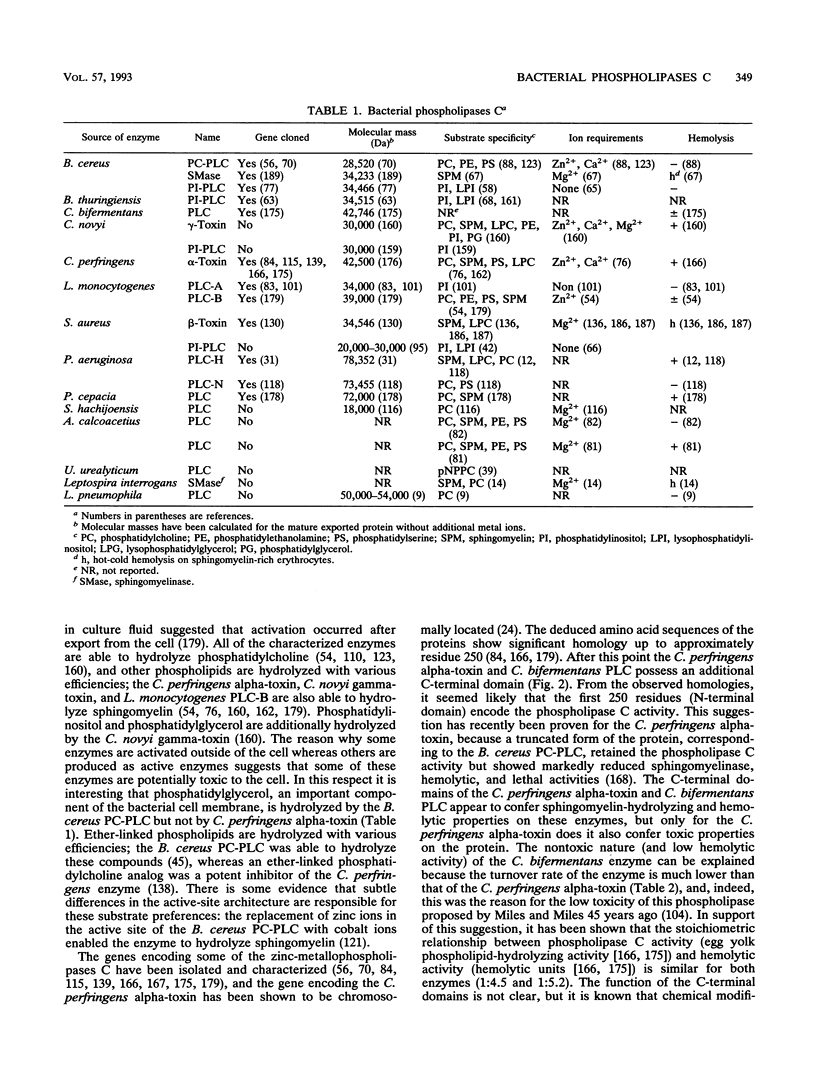
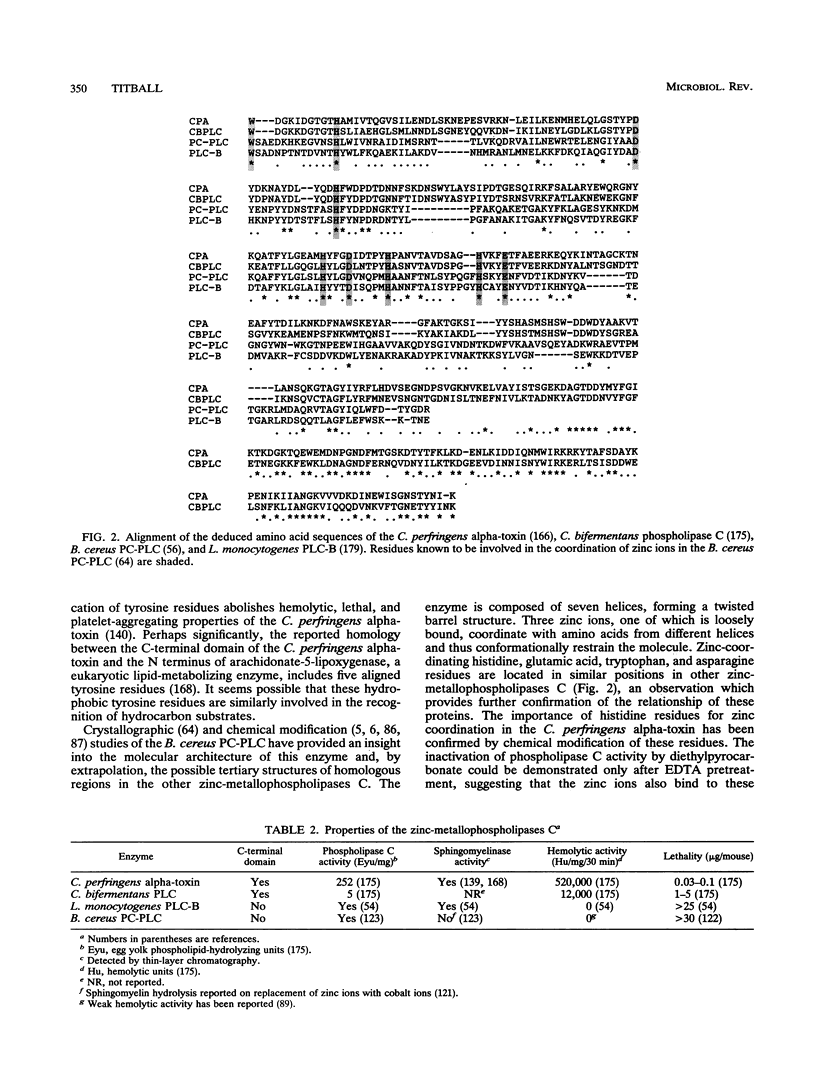
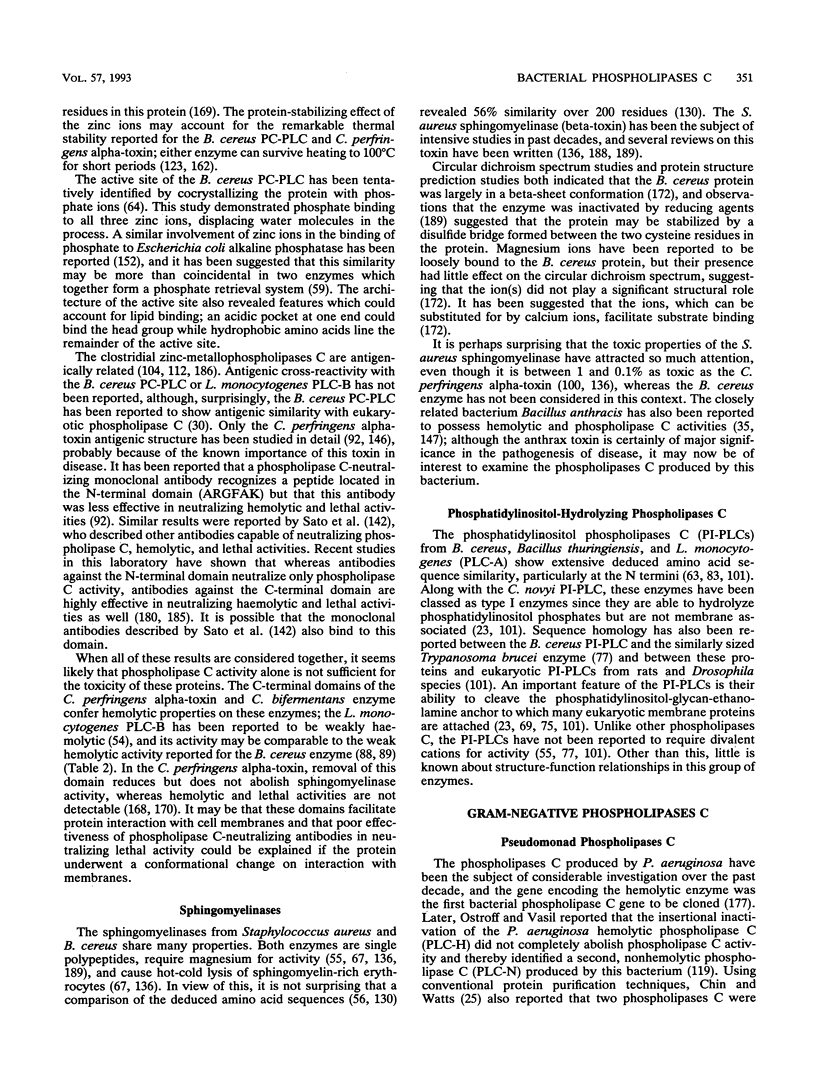
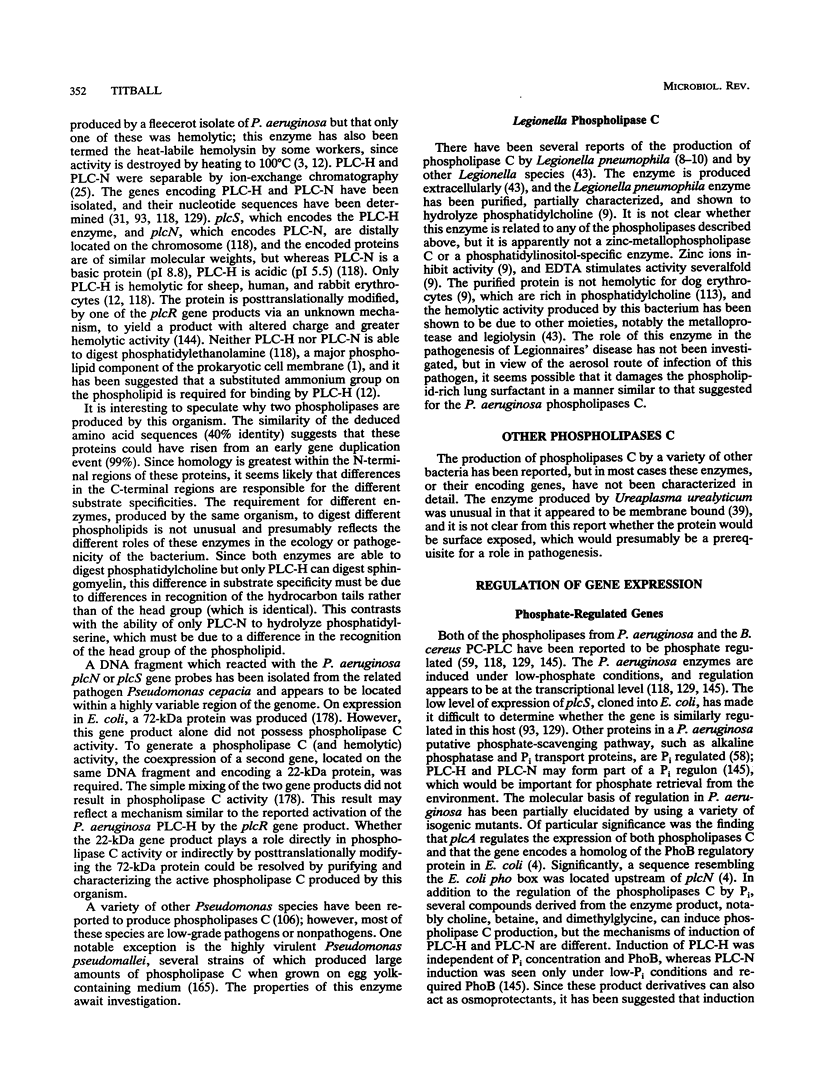
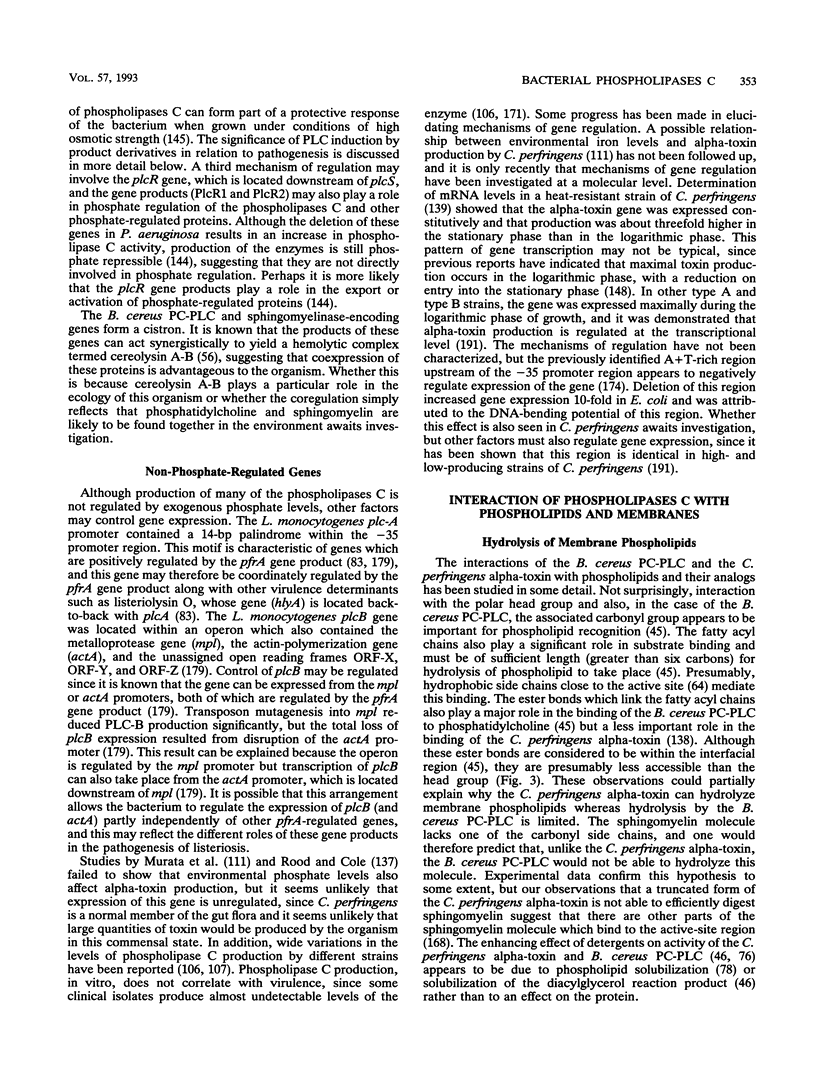
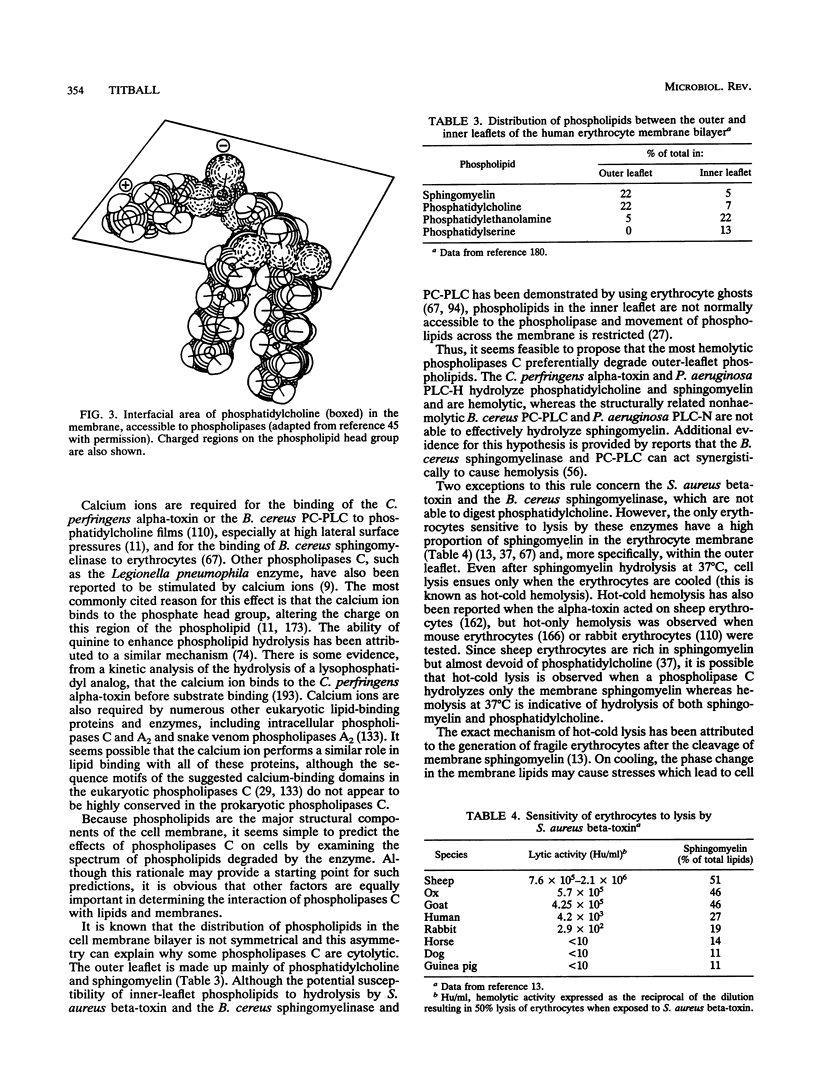
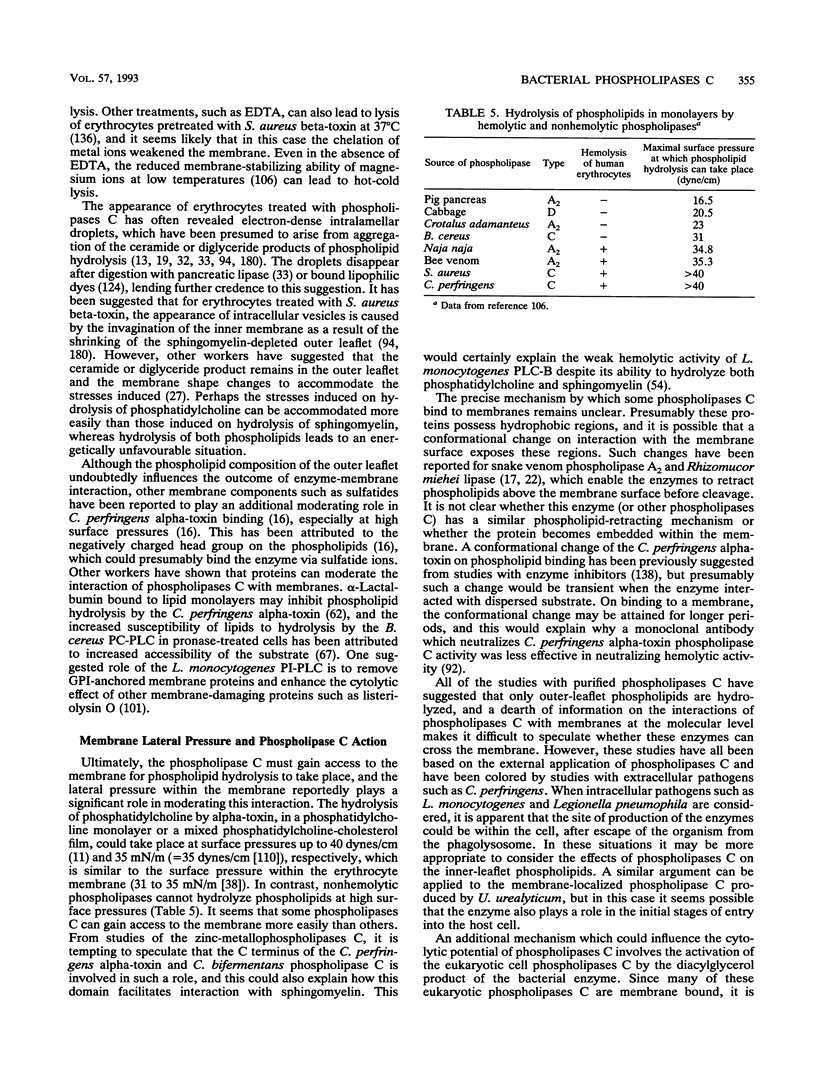
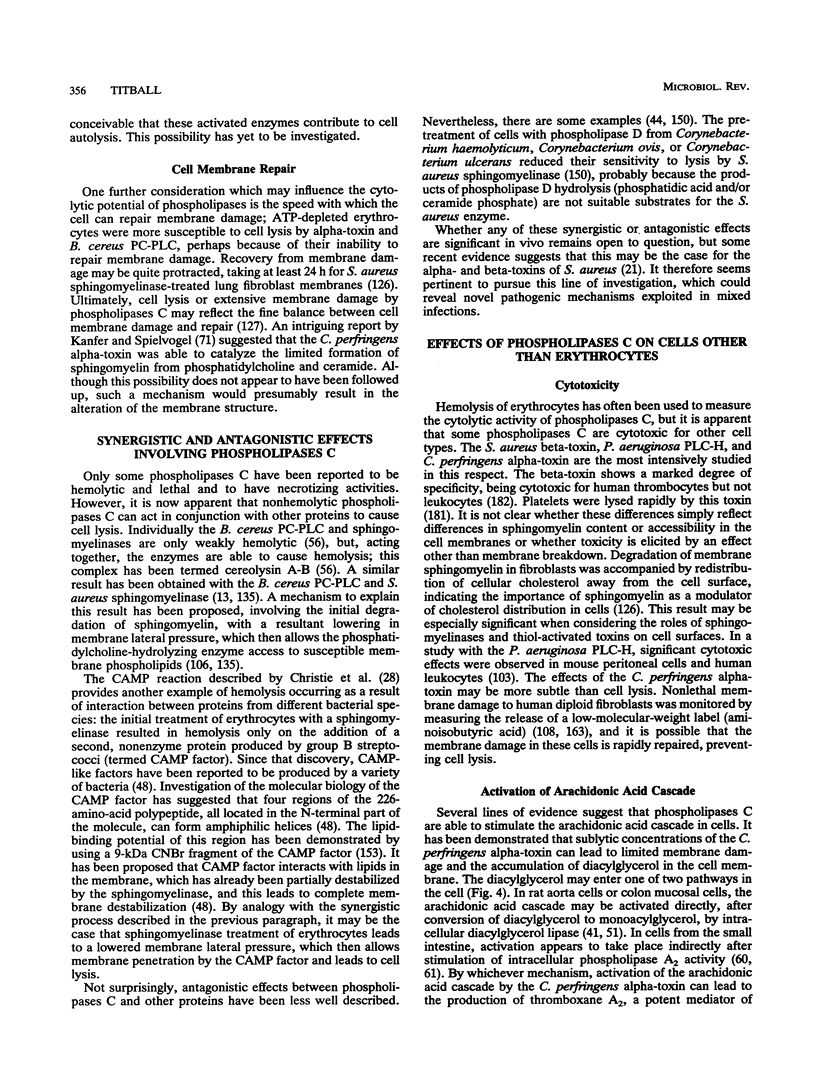
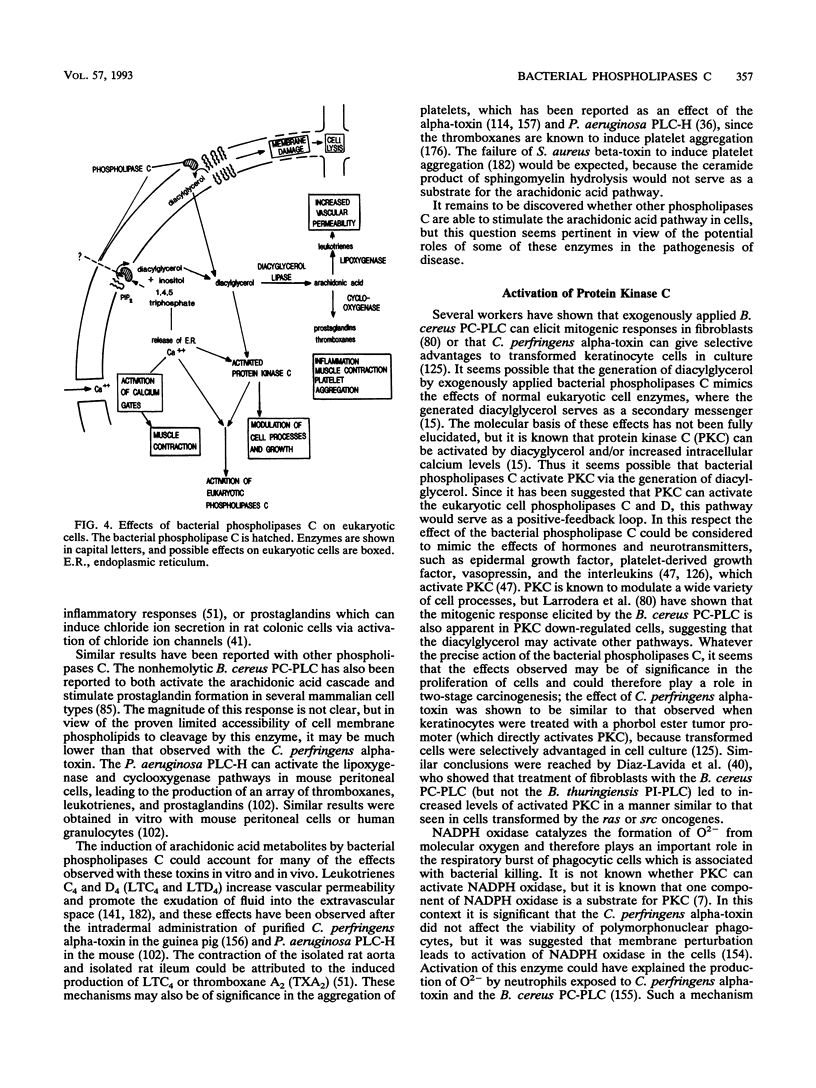
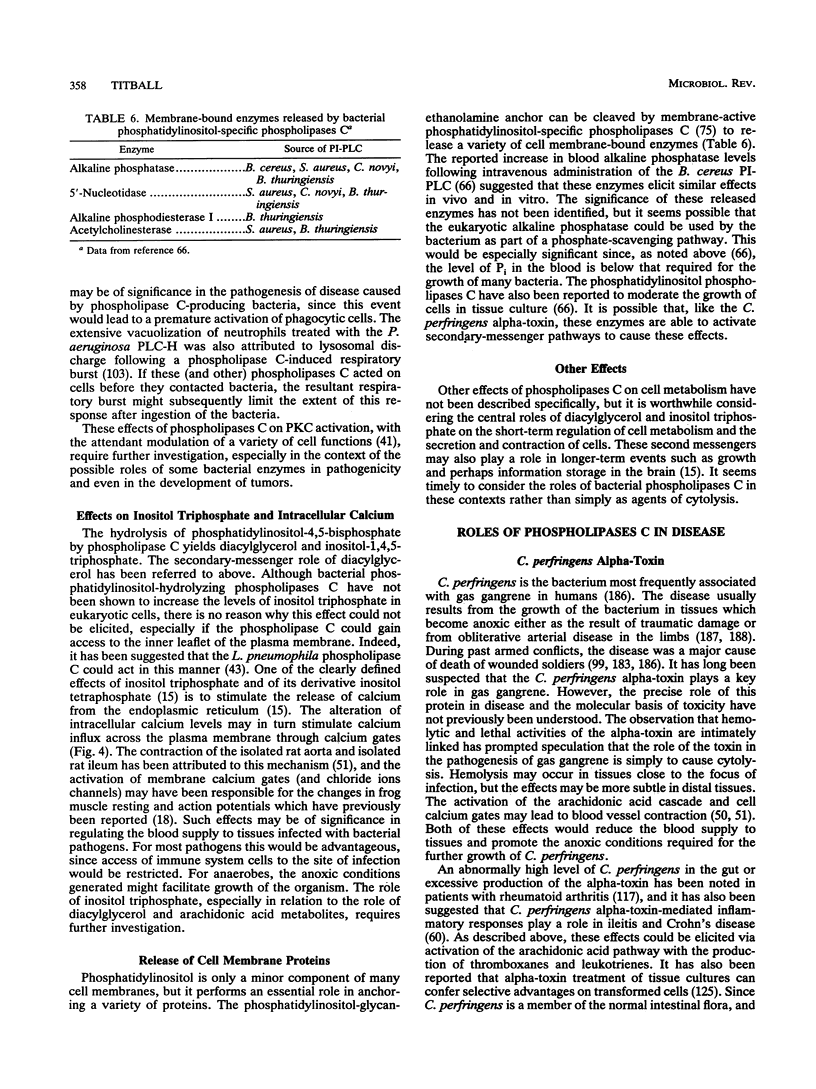
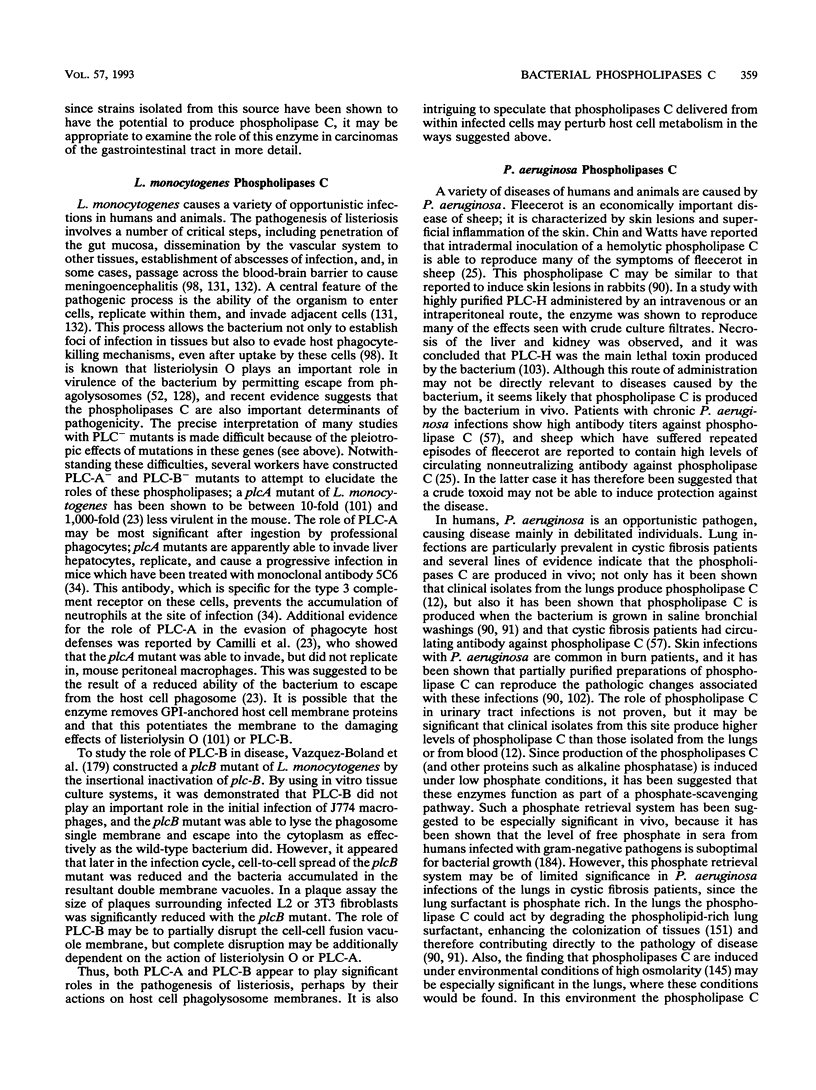
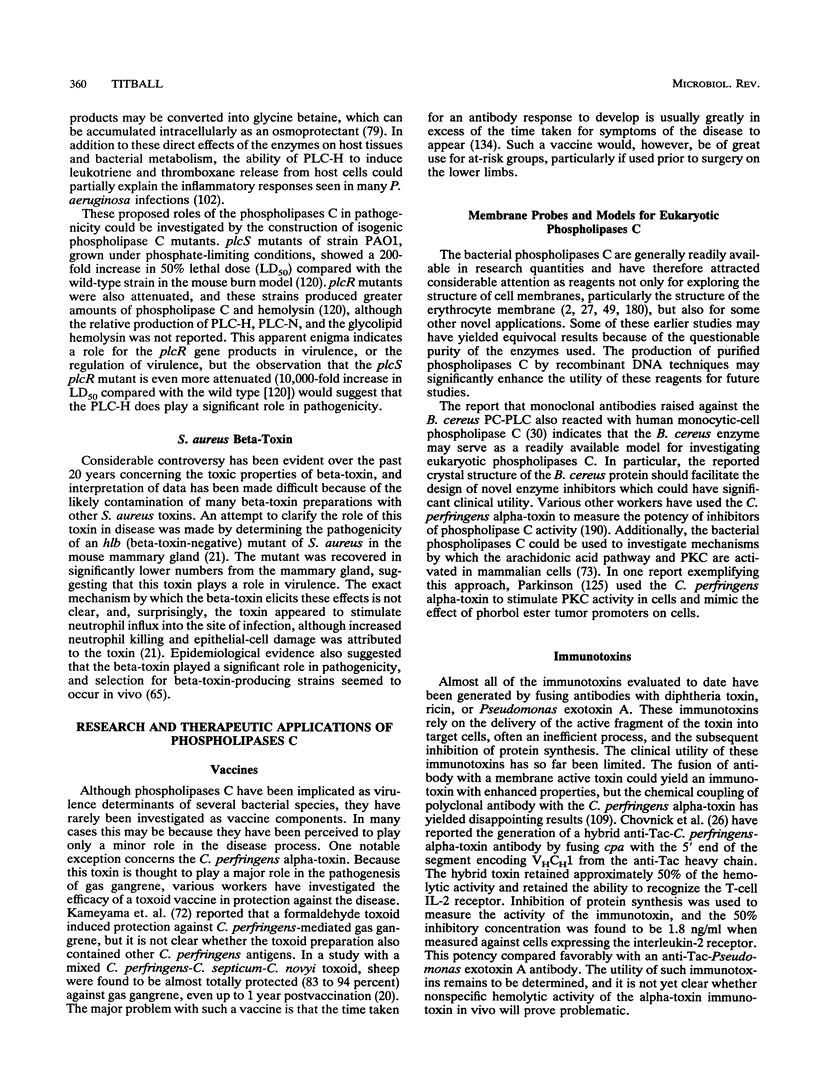
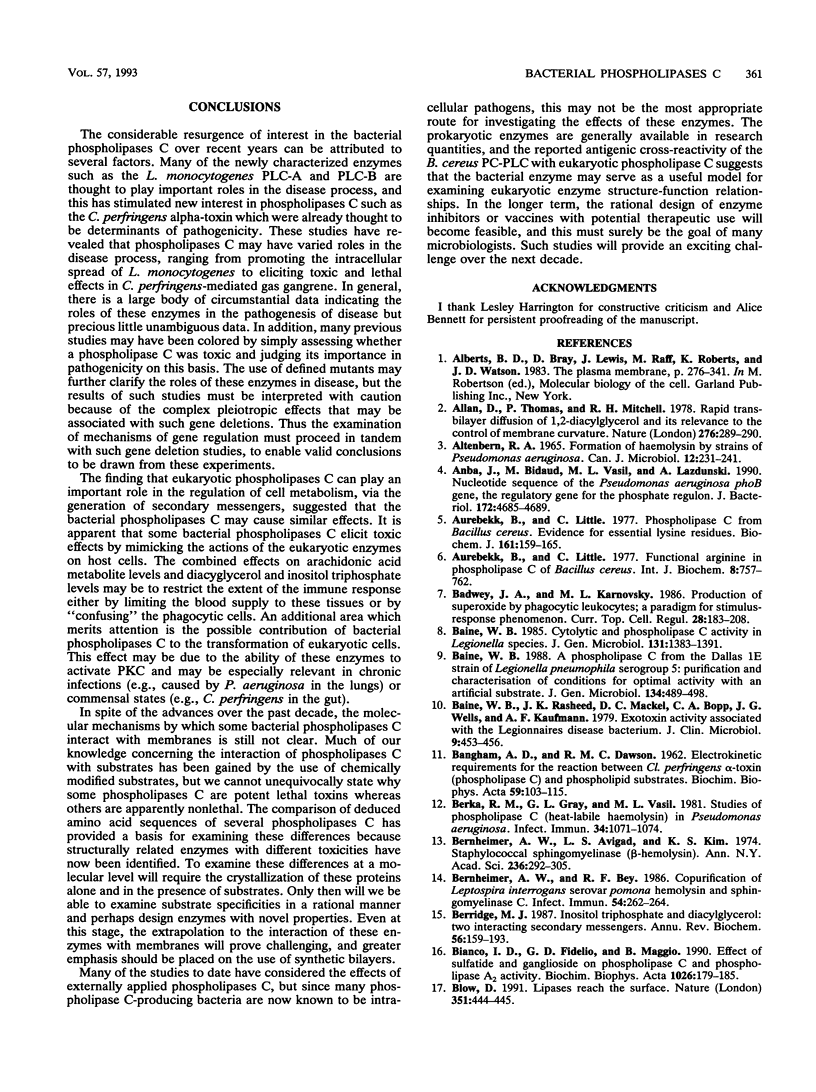
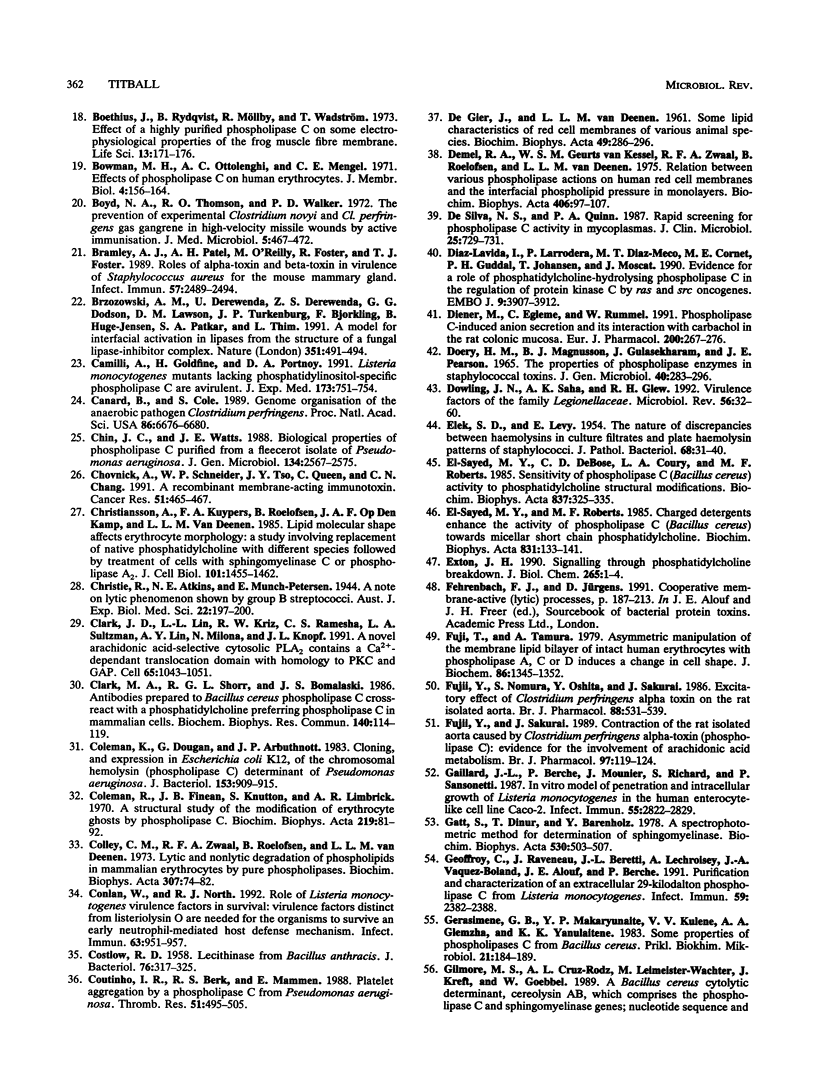
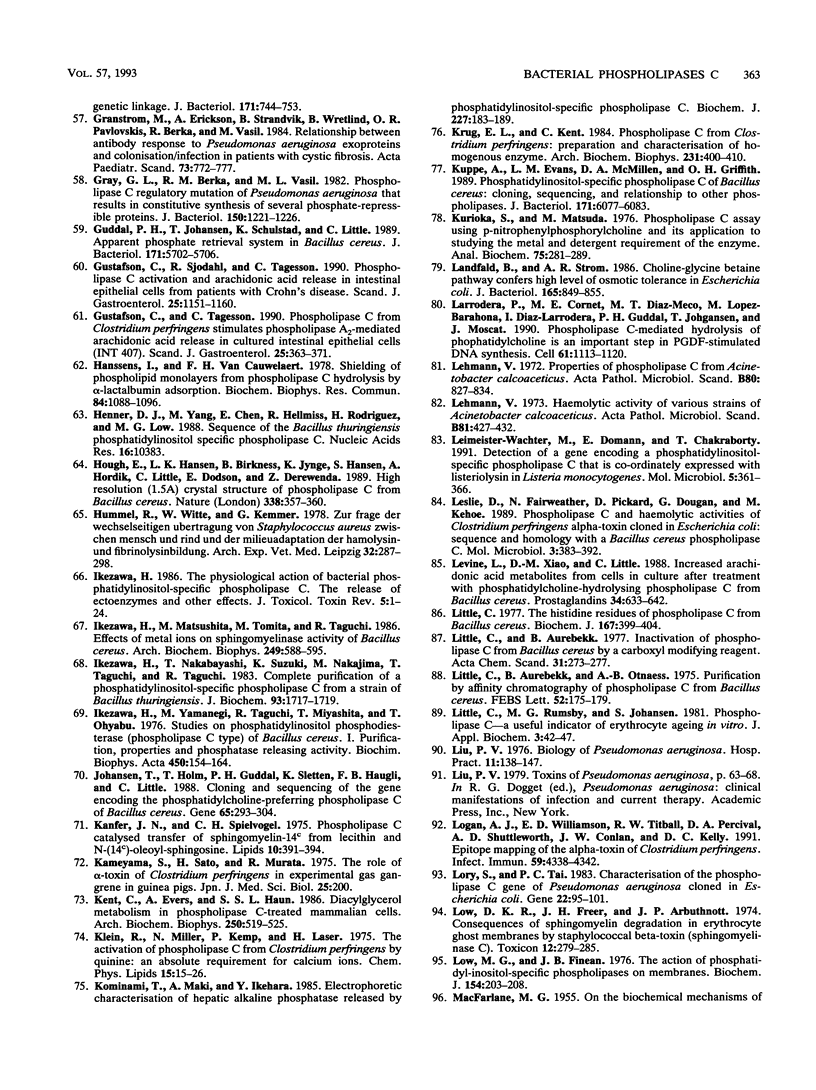
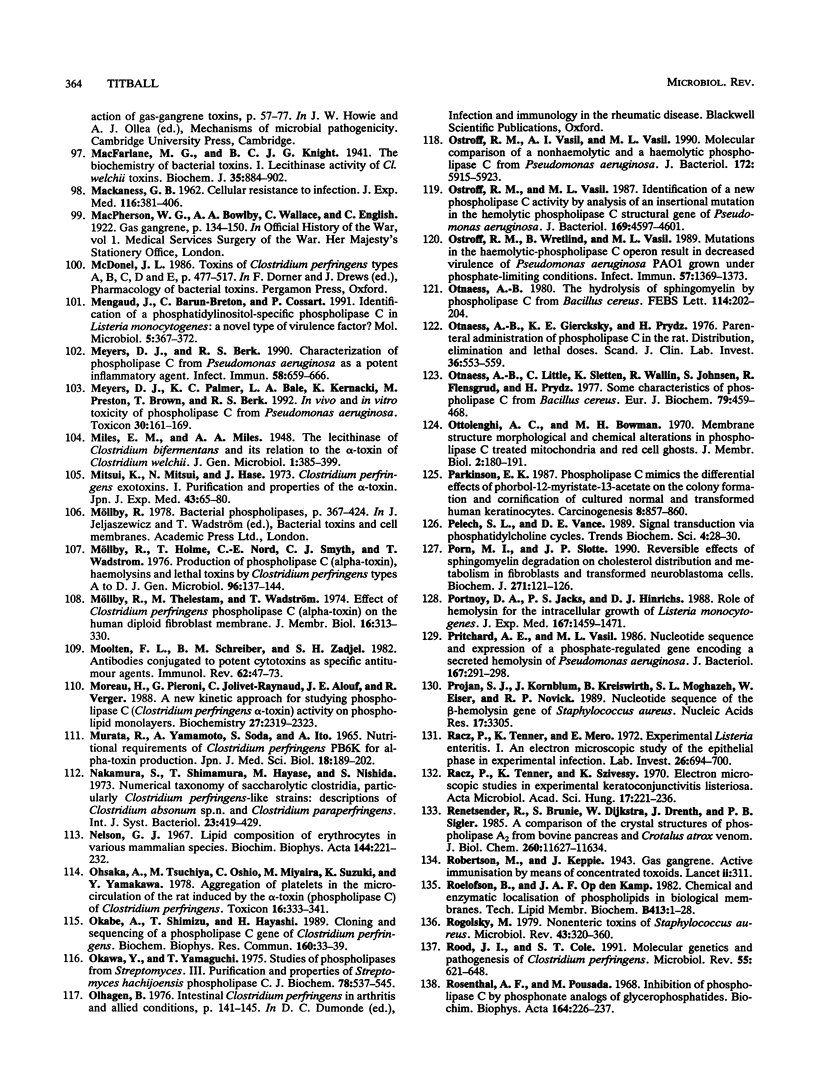
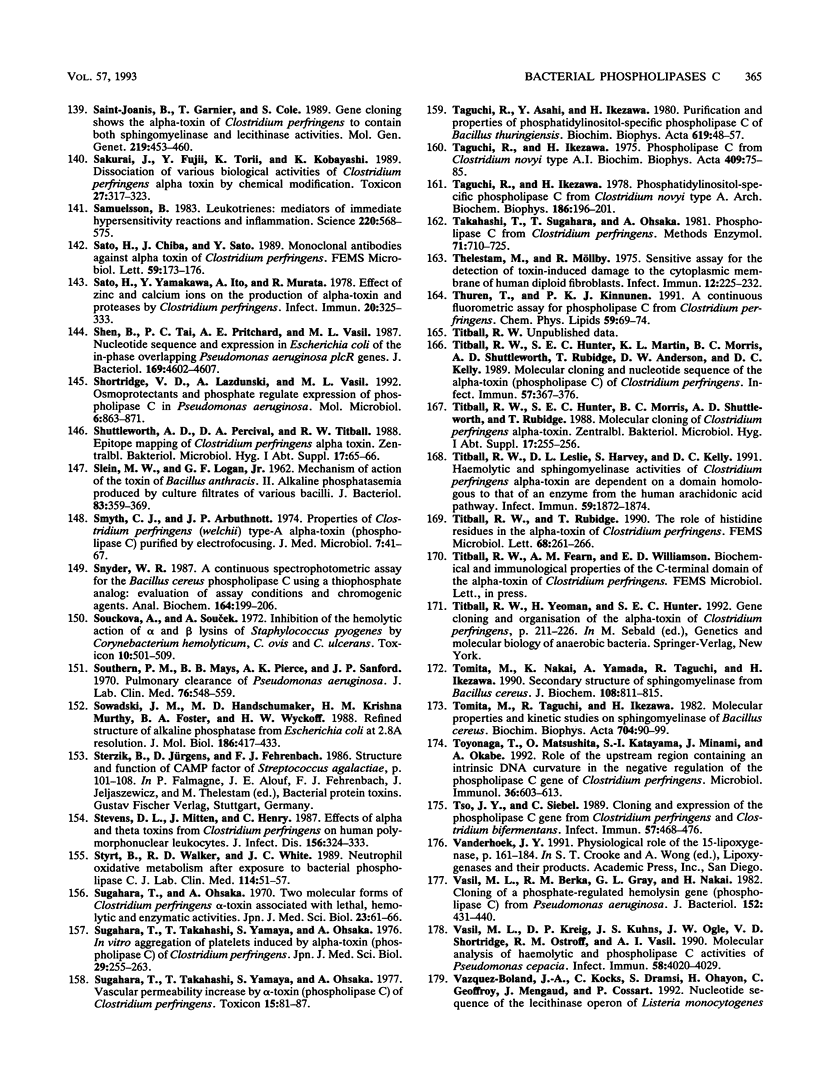
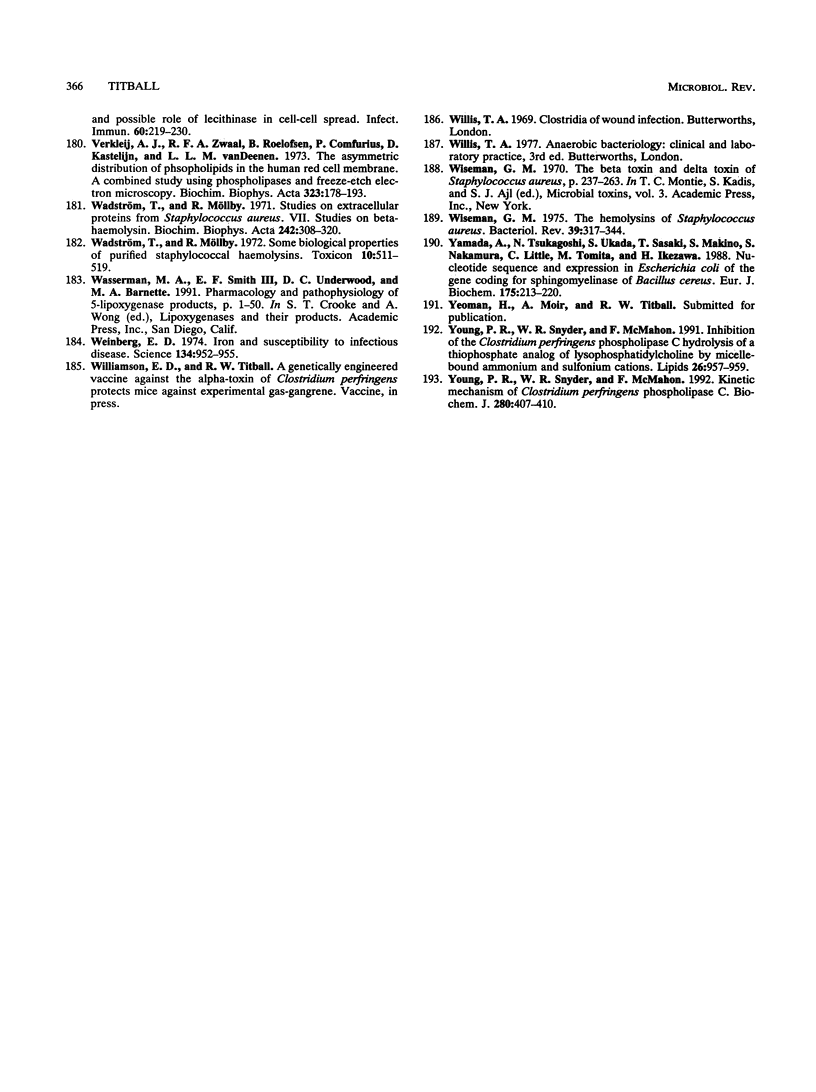
Selected References
These references are in PubMed. This may not be the complete list of references from this article.
- Allan D., Thomas P., Michell R. H. Rapid transbilayer diffusion of 1,2-diacylglycerol and its relevance to control of membrane curvature. Nature. 1978 Nov 16;276(5685):289–290. doi: 10.1038/276289a0. [DOI] [PubMed] [Google Scholar]
- Altenbern R. A. Formation of hemolysin by strains of Pseudomonas aeruginosa. Can J Microbiol. 1966 Apr;12(2):231–241. doi: 10.1139/m66-032. [DOI] [PubMed] [Google Scholar]
- Anba J., Bidaud M., Vasil M. L., Lazdunski A. Nucleotide sequence of the Pseudomonas aeruginosa phoB gene, the regulatory gene for the phosphate regulon. J Bacteriol. 1990 Aug;172(8):4685–4689. doi: 10.1128/jb.172.8.4685-4689.1990. [DOI] [PMC free article] [PubMed] [Google Scholar]
- Aurebekk B., Little C. Phospholipase C from Bacillus cereus. Evidence for essential lysine residues. Biochem J. 1977 Jan 1;161(1):159–165. doi: 10.1042/bj1610159. [DOI] [PMC free article] [PubMed] [Google Scholar]
- BANGHAM A. D., DAWSON R. M. Electrokinetic requirements for the reaction between Cl. perfringens alpha-toxin (phospholipase C) and phospholipid substrates. Biochim Biophys Acta. 1962 May 7;59:103–115. doi: 10.1016/0006-3002(62)90701-1. [DOI] [PubMed] [Google Scholar]
- Badwey J. A., Karnovsky M. L. Production of superoxide by phagocytic leukocytes: a paradigm for stimulus-response phenomena. Curr Top Cell Regul. 1986;28:183–208. doi: 10.1016/b978-0-12-152828-7.50006-8. [DOI] [PubMed] [Google Scholar]
- Baine W. B. A phospholipase C from the Dallas 1E strain of Legionella pneumophila serogroup 5: purification and characterization of conditions for optimal activity with an artificial substrate. J Gen Microbiol. 1988 Feb;134(2):489–498. doi: 10.1099/00221287-134-2-489. [DOI] [PubMed] [Google Scholar]
- Baine W. B. Cytolytic and phospholipase C activity in Legionella species. J Gen Microbiol. 1985 Jun;131(6):1383–1391. doi: 10.1099/00221287-131-6-1383. [DOI] [PubMed] [Google Scholar]
- Baine W. B., Rasheed J. K., Mackel D. C., Bopp C. A., Wells J. G., Kaufmann A. F. Exotoxin activity associated with the Legionnaires disease bacterium. J Clin Microbiol. 1979 Mar;9(3):453–456. doi: 10.1128/jcm.9.3.453-456.1979. [DOI] [PMC free article] [PubMed] [Google Scholar]
- Berka R. M., Gray G. L., Vasil M. L. Studies of phospholipase C (heat-labile hemolysin) in Pseudomonas aeruginosa. Infect Immun. 1981 Dec;34(3):1071–1074. doi: 10.1128/iai.34.3.1071-1074.1981. [DOI] [PMC free article] [PubMed] [Google Scholar]
- Bernheimer A. W., Avigad L. S., Kim K. S. Staphylococcal sphingomyelinase (beta-hemolysin). Ann N Y Acad Sci. 1974 Jul 31;236(0):292–306. doi: 10.1111/j.1749-6632.1974.tb41499.x. [DOI] [PubMed] [Google Scholar]
- Bernheimer A. W., Bey R. F. Copurification of Leptospira interrogans serovar pomona hemolysin and sphingomyelinase C. Infect Immun. 1986 Oct;54(1):262–264. doi: 10.1128/iai.54.1.262-264.1986. [DOI] [PMC free article] [PubMed] [Google Scholar]
- Berridge M. J. Inositol trisphosphate and diacylglycerol: two interacting second messengers. Annu Rev Biochem. 1987;56:159–193. doi: 10.1146/annurev.bi.56.070187.001111. [DOI] [PubMed] [Google Scholar]
- Bianco I. D., Fidelio G. D., Maggio B. Effect of sulfatide and gangliosides on phospholipase C and phospholipase A2 activity. A monolayer study. Biochim Biophys Acta. 1990 Jul 24;1026(2):179–185. doi: 10.1016/0005-2736(90)90062-s. [DOI] [PubMed] [Google Scholar]
- Blow D. Enzymology. Lipases reach the surface. Nature. 1991 Jun 6;351(6326):444–445. doi: 10.1038/351444a0. [DOI] [PubMed] [Google Scholar]
- Boyd N. A., Thomson R. O., Walker P. D. The prevention of experimental Clostridium novyi and Cl. perfringens gas gangrene in high-velocity missile wounds by active immunisation. J Med Microbiol. 1972 Nov;5(4):467–472. doi: 10.1099/00222615-5-4-467. [DOI] [PubMed] [Google Scholar]
- Boëthius J., Rydqvist B., Möllby R., Wadström T. Effect of a highly purified phospholipase C on some electrophysiological properties of the frog muscle fibre membrane. Life Sci. 1973 Jul 16;13(2):171–176. doi: 10.1016/0024-3205(73)90192-6. [DOI] [PubMed] [Google Scholar]
- Bramley A. J., Patel A. H., O'Reilly M., Foster R., Foster T. J. Roles of alpha-toxin and beta-toxin in virulence of Staphylococcus aureus for the mouse mammary gland. Infect Immun. 1989 Aug;57(8):2489–2494. doi: 10.1128/iai.57.8.2489-2494.1989. [DOI] [PMC free article] [PubMed] [Google Scholar]
- Brzozowski A. M., Derewenda U., Derewenda Z. S., Dodson G. G., Lawson D. M., Turkenburg J. P., Bjorkling F., Huge-Jensen B., Patkar S. A., Thim L. A model for interfacial activation in lipases from the structure of a fungal lipase-inhibitor complex. Nature. 1991 Jun 6;351(6326):491–494. doi: 10.1038/351491a0. [DOI] [PubMed] [Google Scholar]
- COSTLOW R. D. Lecithinase from Bacillus anthracis. J Bacteriol. 1958 Sep;76(3):317–325. doi: 10.1128/jb.76.3.317-325.1958. [DOI] [PMC free article] [PubMed] [Google Scholar]
- Camilli A., Goldfine H., Portnoy D. A. Listeria monocytogenes mutants lacking phosphatidylinositol-specific phospholipase C are avirulent. J Exp Med. 1991 Mar 1;173(3):751–754. doi: 10.1084/jem.173.3.751. [DOI] [PMC free article] [PubMed] [Google Scholar]
- Canard B., Cole S. T. Genome organization of the anaerobic pathogen Clostridium perfringens. Proc Natl Acad Sci U S A. 1989 Sep;86(17):6676–6680. doi: 10.1073/pnas.86.17.6676. [DOI] [PMC free article] [PubMed] [Google Scholar]
- Chin J. C., Watts J. E. Biological properties of phospholipase C purified from a fleecerot isolate of Pseudomonas aeruginosa. J Gen Microbiol. 1988 Sep;134(9):2567–2575. doi: 10.1099/00221287-134-9-2567. [DOI] [PubMed] [Google Scholar]
- Chovnick A., Schneider W. P., Tso J. Y., Queen C., Chang C. N. A recombinant, membrane-acting immunotoxin. Cancer Res. 1991 Jan 15;51(2):465–467. [PubMed] [Google Scholar]
- Christiansson A., Kuypers F. A., Roelofsen B., Op den Kamp J. A., van Deenen L. L. Lipid molecular shape affects erythrocyte morphology: a study involving replacement of native phosphatidylcholine with different species followed by treatment of cells with sphingomyelinase C or phospholipase A2. J Cell Biol. 1985 Oct;101(4):1455–1462. doi: 10.1083/jcb.101.4.1455. [DOI] [PMC free article] [PubMed] [Google Scholar]
- Clark J. D., Lin L. L., Kriz R. W., Ramesha C. S., Sultzman L. A., Lin A. Y., Milona N., Knopf J. L. A novel arachidonic acid-selective cytosolic PLA2 contains a Ca(2+)-dependent translocation domain with homology to PKC and GAP. Cell. 1991 Jun 14;65(6):1043–1051. doi: 10.1016/0092-8674(91)90556-e. [DOI] [PubMed] [Google Scholar]
- Clark M. A., Shorr R. G., Bomalaski J. S. Antibodies prepared to Bacillus cereus phospholipase C crossreact with a phosphatidylcholine preferring phospholipase C in mammalian cells. Biochem Biophys Res Commun. 1986 Oct 15;140(1):114–119. doi: 10.1016/0006-291x(86)91065-x. [DOI] [PubMed] [Google Scholar]
- Coleman K., Dougan G., Arbuthnott J. P. Cloning, and expression in Escherichia coli K-12, of the chromosomal hemolysin (phospholipase C) determinant of Pseudomonas aeruginosa. J Bacteriol. 1983 Feb;153(2):909–915. doi: 10.1128/jb.153.2.909-915.1983. [DOI] [PMC free article] [PubMed] [Google Scholar]
- Coleman R., Finean J. B., Knutton S., Limbrick A. R. A structural study of the modification of erythrocyte ghosts by phospholipase C. Biochim Biophys Acta. 1970;219(1):81–92. doi: 10.1016/0005-2736(70)90063-5. [DOI] [PubMed] [Google Scholar]
- Colley C. M., Zwaal R. F., Roelofsen B., van Deenen L. L. Lytic and non-lytic degradation of phospholipids in mammalian erythrocytes by pure phospholipases. Biochim Biophys Acta. 1973 Apr 25;307(1):74–82. doi: 10.1016/0005-2736(73)90026-6. [DOI] [PubMed] [Google Scholar]
- Conlan J. W., North R. J. Roles of Listeria monocytogenes virulence factors in survival: virulence factors distinct from listeriolysin are needed for the organism to survive an early neutrophil-mediated host defense mechanism. Infect Immun. 1992 Mar;60(3):951–957. doi: 10.1128/iai.60.3.951-957.1992. [DOI] [PMC free article] [PubMed] [Google Scholar]
- Coutinho I. R., Berk R. S., Mammen E. Platelet aggregation by a phospholipase C from Pseudomonas aeruginosa. Thromb Res. 1988 Sep 1;51(5):495–505. doi: 10.1016/0049-3848(88)90115-6. [DOI] [PubMed] [Google Scholar]
- De Silva N. S., Quinn P. A. Rapid screening assay for phospholipase C activity in mycoplasmas. J Clin Microbiol. 1987 Apr;25(4):729–731. doi: 10.1128/jcm.25.4.729-731.1987. [DOI] [PMC free article] [PubMed] [Google Scholar]
- Demel R. A., Geurts van Kessel W. S., Zwaal R. F., Roelofsen B., van Deenen L. L. Relation between various phospholipase actions on human red cell membranes and the interfacial phospholipid pressure in monolayers. Biochim Biophys Acta. 1975 Sep 16;406(1):97–107. doi: 10.1016/0005-2736(75)90045-0. [DOI] [PubMed] [Google Scholar]
- Diaz-Laviada I., Larrodera P., Diaz-Meco M. T., Cornet M. E., Guddal P. H., Johansen T., Moscat J. Evidence for a role of phosphatidylcholine-hydrolysing phospholipase C in the regulation of protein kinase C by ras and src oncogenes. EMBO J. 1990 Dec;9(12):3907–3912. doi: 10.1002/j.1460-2075.1990.tb07611.x. [DOI] [PMC free article] [PubMed] [Google Scholar]
- Diener M., Eglème C., Rummel W. Phospholipase C-induced anion secretion and its interaction with carbachol in the rat colonic mucosa. Eur J Pharmacol. 1991 Aug 6;200(2-3):267–276. doi: 10.1016/0014-2999(91)90581-a. [DOI] [PubMed] [Google Scholar]
- Doery H. M., Magnusson B. J., Gulasekharam J., Pearson J. E. The properties of phospholipase enzymes in staphylococcal toxins. J Gen Microbiol. 1965 Aug;40(2):283–296. doi: 10.1099/00221287-40-2-283. [DOI] [PubMed] [Google Scholar]
- Dowling J. N., Saha A. K., Glew R. H. Virulence factors of the family Legionellaceae. Microbiol Rev. 1992 Mar;56(1):32–60. doi: 10.1128/mr.56.1.32-60.1992. [DOI] [PMC free article] [PubMed] [Google Scholar]
- ELEK S. D., LEVY E. The nature of discrepancies between haemolysins in culture filtrates and plate haemolysin patterns of staphylococci. J Pathol Bacteriol. 1954 Jul;68(1):31–40. doi: 10.1002/path.1700680105. [DOI] [PubMed] [Google Scholar]
- Exton J. H. Signaling through phosphatidylcholine breakdown. J Biol Chem. 1990 Jan 5;265(1):1–4. [PubMed] [Google Scholar]
- Fujii T., Tamura A. Asymmetric manipulation of the membrane lipid bilayer of intact human erythrocytes with phospholipase A, C, or D induces a change in cell shape. J Biochem. 1979 Nov;86(5):1345–1352. doi: 10.1093/oxfordjournals.jbchem.a132651. [DOI] [PubMed] [Google Scholar]
- Fujii Y., Nomura S., Oshita Y., Sakurai J. Excitatory effect of Clostridium perfringens alpha toxin on the rat isolated aorta. Br J Pharmacol. 1986 Jul;88(3):531–539. doi: 10.1111/j.1476-5381.1986.tb10233.x. [DOI] [PMC free article] [PubMed] [Google Scholar]
- Fujii Y., Sakurai J. Contraction of the rat isolated aorta caused by Clostridium perfringens alpha toxin (phospholipase C): evidence for the involvement of arachidonic acid metabolism. Br J Pharmacol. 1989 May;97(1):119–124. doi: 10.1111/j.1476-5381.1989.tb11931.x. [DOI] [PMC free article] [PubMed] [Google Scholar]
- Gaillard J. L., Berche P., Mounier J., Richard S., Sansonetti P. In vitro model of penetration and intracellular growth of Listeria monocytogenes in the human enterocyte-like cell line Caco-2. Infect Immun. 1987 Nov;55(11):2822–2829. doi: 10.1128/iai.55.11.2822-2829.1987. [DOI] [PMC free article] [PubMed] [Google Scholar]
- Gatt S., Dinur T., Barenholz Y. A spectrophotometric method for determination of sphingomyelinase. Biochim Biophys Acta. 1978 Sep 28;530(3):503–507. doi: 10.1016/0005-2760(78)90169-8. [DOI] [PubMed] [Google Scholar]
- Geoffroy C., Raveneau J., Beretti J. L., Lecroisey A., Vazquez-Boland J. A., Alouf J. E., Berche P. Purification and characterization of an extracellular 29-kilodalton phospholipase C from Listeria monocytogenes. Infect Immun. 1991 Jul;59(7):2382–2388. doi: 10.1128/iai.59.7.2382-2388.1991. [DOI] [PMC free article] [PubMed] [Google Scholar]
- Granström M., Ericsson A., Strandvik B., Wretlind B., Pavlovskis O. R., Berka R., Vasil M. L. Relation between antibody response to Pseudomonas aeruginosa exoproteins and colonization/infection in patients with cystic fibrosis. Acta Paediatr Scand. 1984 Nov;73(6):772–777. doi: 10.1111/j.1651-2227.1984.tb17774.x. [DOI] [PubMed] [Google Scholar]
- Gray G. L., Berka R. M., Vasil M. L. Phospholipase C regulatory mutation of Pseudomonas aeruginosa that results in constitutive synthesis of several phosphate-repressible proteins. J Bacteriol. 1982 Jun;150(3):1221–1226. doi: 10.1128/jb.150.3.1221-1226.1982. [DOI] [PMC free article] [PubMed] [Google Scholar]
- Guddal P. H., Johansen T., Schulstad K., Little C. Apparent phosphate retrieval system in Bacillus cereus. J Bacteriol. 1989 Oct;171(10):5702–5706. doi: 10.1128/jb.171.10.5702-5706.1989. [DOI] [PMC free article] [PubMed] [Google Scholar]
- Gustafson C., Sjödahl R., Tagesson C. Phospholipase activation and arachidonic acid release in intestinal epithelial cells from patients with Crohn's disease. Scand J Gastroenterol. 1990 Nov;25(11):1151–1160. doi: 10.3109/00365529008998548. [DOI] [PubMed] [Google Scholar]
- Gustafson C., Tagesson C. Phospholipase C from Clostridium perfringens stimulates phospholipase A2-mediated arachidonic acid release in cultured intestinal epithelial cells (INT 407). Scand J Gastroenterol. 1990 Apr;25(4):363–371. doi: 10.3109/00365529009095500. [DOI] [PubMed] [Google Scholar]
- Hanssens I., Van Cauwelaert F. H. Shielding of phospholipid monolayers from phospholipase C hydrolysis by alpha-lactalbumin adsorption. Biochem Biophys Res Commun. 1978 Oct 30;84(4):1088–1096. doi: 10.1016/0006-291x(78)91695-9. [DOI] [PubMed] [Google Scholar]
- Henner D. J., Yang M., Chen E., Hellmiss R., Rodriguez H., Low M. G. Sequence of the Bacillus thuringiensis phosphatidylinositol specific phospholipase C. Nucleic Acids Res. 1988 Nov 11;16(21):10383–10383. doi: 10.1093/nar/16.21.10383. [DOI] [PMC free article] [PubMed] [Google Scholar]
- Hough E., Hansen L. K., Birknes B., Jynge K., Hansen S., Hordvik A., Little C., Dodson E., Derewenda Z. High-resolution (1.5 A) crystal structure of phospholipase C from Bacillus cereus. Nature. 1989 Mar 23;338(6213):357–360. doi: 10.1038/338357a0. [DOI] [PubMed] [Google Scholar]
- Hummel R., Witte W., Kemmer G. Zur Frage der wechselseitigen Ubertragung von Staphylococcus aureus zwischen Mensch und Rind und der Milieuadaptation der Hämolysin- und Fibrinolysinbildung. Arch Exp Veterinarmed. 1978;32(2):287–298. [PubMed] [Google Scholar]
- Ikezawa H., Matsushita M., Tomita M., Taguchi R. Effects of metal ions on sphingomyelinase activity of Bacillus cereus. Arch Biochem Biophys. 1986 Sep;249(2):588–595. doi: 10.1016/0003-9861(86)90037-8. [DOI] [PubMed] [Google Scholar]
- Ikezawa H., Nakabayashi T., Suzuki K., Nakajima M., Taguchi T., Taguchi R. Complete purification of phosphatidylinositol-specific phospholipase C from a strain of Bacillus thuringiensis. J Biochem. 1983 Jun;93(6):1717–1719. doi: 10.1093/oxfordjournals.jbchem.a134315. [DOI] [PubMed] [Google Scholar]
- Ikezawa H., Yamanegi M., Taguchi R., Miyashita T., Ohyabu T. Studies on phosphatidylinositol phosphodiesterase (phospholipase C type) of Bacillus cereus. I. purification, properties and phosphatase-releasing activity. Biochim Biophys Acta. 1976 Nov 19;450(2):154–164. [PubMed] [Google Scholar]
- Johansen T., Holm T., Guddal P. H., Sletten K., Haugli F. B., Little C. Cloning and sequencing of the gene encoding the phosphatidylcholine-preferring phospholipase C of Bacillus cereus. Gene. 1988 May 30;65(2):293–304. doi: 10.1016/0378-1119(88)90466-0. [DOI] [PubMed] [Google Scholar]
- Kameyama S., Sato H., Murata R. The role of alpha-toxin of Clostridium perfringens in experimental gas gangrene in guinea pigs. Jpn J Med Sci Biol. 1972 Jun;25(3):200–200. [PubMed] [Google Scholar]
- Kanfer J. N., Spielvogel C. H. Phospholipase C catalyzed formation of sphinogomyelin--14C from lecithin and N-(-14C)-oleoyl-sphingosine. Lipids. 1975 Jul;10(7):391–394. [PubMed] [Google Scholar]
- Kent C., Evers A., Haun S. S. Diacylglycerol metabolism in phospholipase C-treated mammalian cells. Arch Biochem Biophys. 1986 Nov 1;250(2):519–525. doi: 10.1016/0003-9861(86)90757-5. [DOI] [PubMed] [Google Scholar]
- Klein R., Miller N., Kemp P., Laser H. The activation of phospholipase C from Clostridium Welchii by quinine: an absolute requirement for calcium ions. Chem Phys Lipids. 1975 Sep;15(1):15–26. doi: 10.1016/0009-3084(75)90027-4. [DOI] [PubMed] [Google Scholar]
- Kominami T., Miki A., Ikehara Y. Electrophoretic characterization of hepatic alkaline phosphatase released by phosphatidylinositol-specific phospholipase C. A comparison with liver membrane and serum-soluble forms. Biochem J. 1985 Apr 1;227(1):183–189. doi: 10.1042/bj2270183. [DOI] [PMC free article] [PubMed] [Google Scholar]
- Krug E. L., Kent C. Phospholipase C from Clostridium perfringens: preparation and characterization of homogeneous enzyme. Arch Biochem Biophys. 1984 Jun;231(2):400–410. doi: 10.1016/0003-9861(84)90403-x. [DOI] [PubMed] [Google Scholar]
- Kuppe A., Evans L. M., McMillen D. A., Griffith O. H. Phosphatidylinositol-specific phospholipase C of Bacillus cereus: cloning, sequencing, and relationship to other phospholipases. J Bacteriol. 1989 Nov;171(11):6077–6083. doi: 10.1128/jb.171.11.6077-6083.1989. [DOI] [PMC free article] [PubMed] [Google Scholar]
- Kurioka S., Matsuda M. Phospholipase C assay using p-nitrophenylphosphoryl-choline together with sorbitol and its application to studying the metal and detergent requirement of the enzyme. Anal Biochem. 1976 Sep;75(1):281–289. doi: 10.1016/0003-2697(76)90078-6. [DOI] [PubMed] [Google Scholar]
- Landfald B., Strøm A. R. Choline-glycine betaine pathway confers a high level of osmotic tolerance in Escherichia coli. J Bacteriol. 1986 Mar;165(3):849–855. doi: 10.1128/jb.165.3.849-855.1986. [DOI] [PMC free article] [PubMed] [Google Scholar]
- Larrodera P., Cornet M. E., Diaz-Meco M. T., Lopez-Barahona M., Diaz-Laviada I., Guddal P. H., Johansen T., Moscat J. Phospholipase C-mediated hydrolysis of phosphatidylcholine is an important step in PDGF-stimulated DNA synthesis. Cell. 1990 Jun 15;61(6):1113–1120. doi: 10.1016/0092-8674(90)90074-o. [DOI] [PubMed] [Google Scholar]
- Lehmann V. Haemolytic activity of various strains of Acinetobacter. Acta Pathol Microbiol Scand B Microbiol Immunol. 1973 Aug;81(4):427–432. doi: 10.1111/j.1699-0463.1973.tb02226.x. [DOI] [PubMed] [Google Scholar]
- Lehmann V. Properties of purified phospholipase C from Acinetobacter calcoaceticus. Acta Pathol Microbiol Scand B Microbiol Immunol. 1972;80(6):827–834. doi: 10.1111/j.0365-5563.1973.tb00008.x. [DOI] [PubMed] [Google Scholar]
- Leimeister-Wächter M., Domann E., Chakraborty T. Detection of a gene encoding a phosphatidylinositol-specific phospholipase C that is co-ordinately expressed with listeriolysin in Listeria monocytogenes. Mol Microbiol. 1991 Feb;5(2):361–366. doi: 10.1111/j.1365-2958.1991.tb02117.x. [DOI] [PubMed] [Google Scholar]
- Leslie D., Fairweather N., Pickard D., Dougan G., Kehoe M. Phospholipase C and haemolytic activities of Clostridium perfringens alpha-toxin cloned in Escherichia coli: sequence and homology with a Bacillus cereus phospholipase C. Mol Microbiol. 1989 Mar;3(3):383–392. doi: 10.1111/j.1365-2958.1989.tb00183.x. [DOI] [PubMed] [Google Scholar]
- Levine L., Xiao D. M., Little C. Increased arachidonic acid metabolites from cells in culture after treatment with the phosphatidylcholine-hydrolyzing phospholipase C from Bacillus cereus. Prostaglandins. 1987 Nov;34(5):633–642. doi: 10.1016/0090-6980(87)90288-7. [DOI] [PubMed] [Google Scholar]
- Little C., Aurebekk B. Inactivation of phospholipase C from Bacillus cereus by a carboxyl group modifying reagent. Acta Chem Scand B. 1977;31(4):273–277. doi: 10.3891/acta.chem.scand.31b-0273. [DOI] [PubMed] [Google Scholar]
- Little C., Aurebekk B., Otnaess A. B. Purification by affinity chromatography of phospholipase C from Bacillus cereus. FEBS Lett. 1975 Apr 1;52(2):175–179. doi: 10.1016/0014-5793(75)80800-3. [DOI] [PubMed] [Google Scholar]
- Little C. The histidine residues of phospholipase C from Bacillus cereus. Biochem J. 1977 Nov 1;167(2):399–404. doi: 10.1042/bj1670399. [DOI] [PMC free article] [PubMed] [Google Scholar]
- Logan A. J., Williamson E. D., Titball R. W., Percival D. A., Shuttleworth A. D., Conlan J. W., Kelly D. C. Epitope mapping of the alpha-toxin of Clostridium perfringens. Infect Immun. 1991 Dec;59(12):4338–4342. doi: 10.1128/iai.59.12.4338-4342.1991. [DOI] [PMC free article] [PubMed] [Google Scholar]
- Lory S., Tai P. C. Characterization of the phospholipase C gene of Pseudomonas aeruginosa cloned in Escherichia coli. Gene. 1983 Apr;22(1):95–101. doi: 10.1016/0378-1119(83)90068-9. [DOI] [PubMed] [Google Scholar]
- Low D. K., Freer J. H., Arbuthnott J. P., Möllby R., Wadström T. Consequences of spingomyelin degradation in erythrocyte ghost membranes by staphylococcal beta-toxin (sphingomyelinase C). Toxicon. 1974 May;12(3):279–285. doi: 10.1016/0041-0101(74)90070-1. [DOI] [PubMed] [Google Scholar]
- Low M. G., Finean J. B. The action of phosphatidylinositol-specific phospholipases C on membranes. Biochem J. 1976 Jan 15;154(1):203–208. doi: 10.1042/bj1540203. [DOI] [PMC free article] [PubMed] [Google Scholar]
- MACKANESS G. B. Cellular resistance to infection. J Exp Med. 1962 Sep 1;116:381–406. doi: 10.1084/jem.116.3.381. [DOI] [PMC free article] [PubMed] [Google Scholar]
- Macfarlane M. G., Knight B. C. The biochemistry of bacterial toxins: The lecithinase activity of Cl. welchii toxins. Biochem J. 1941 Sep;35(8-9):884–902. doi: 10.1042/bj0350884. [DOI] [PMC free article] [PubMed] [Google Scholar]
- Mengaud J., Braun-Breton C., Cossart P. Identification of phosphatidylinositol-specific phospholipase C activity in Listeria monocytogenes: a novel type of virulence factor? Mol Microbiol. 1991 Feb;5(2):367–372. doi: 10.1111/j.1365-2958.1991.tb02118.x. [DOI] [PubMed] [Google Scholar]
- Meyers D. J., Berk R. S. Characterization of phospholipase C from Pseudomonas aeruginosa as a potent inflammatory agent. Infect Immun. 1990 Mar;58(3):659–666. doi: 10.1128/iai.58.3.659-666.1990. [DOI] [PMC free article] [PubMed] [Google Scholar]
- Meyers D. J., Palmer K. C., Bale L. A., Kernacki K., Preston M., Brown T., Berk R. S. In vivo and in vitro toxicity of phospholipase C from Pseudomonas aeruginosa. Toxicon. 1992 Feb;30(2):161–169. doi: 10.1016/0041-0101(92)90469-l. [DOI] [PubMed] [Google Scholar]
- Mitsu K., Mitsui N., Hase J. Clostridium perfringens exotoxins. I. Purification and properties of -toxin. Jpn J Exp Med. 1973 Apr;43(2):65–80. [PubMed] [Google Scholar]
- Moolten F. L., Schreiber B. M., Zajdel S. H. Antibodies conjugated to potent cytotoxins as specific antitumor agents. Immunol Rev. 1982;62:47–73. doi: 10.1111/j.1600-065x.1982.tb00389.x. [DOI] [PubMed] [Google Scholar]
- Moreau H., Pieroni G., Jolivet-Reynaud C., Alouf J. E., Verger R. A new kinetic approach for studying phospholipase C (Clostridium perfringens alpha toxin) activity on phospholipid monolayers. Biochemistry. 1988 Apr 5;27(7):2319–2323. doi: 10.1021/bi00407a012. [DOI] [PubMed] [Google Scholar]
- Möllby R., Holme T., Nord C. E., Smyth C. J., Wadström T. Production of phospholipase C (alpha-toxin), haemolysins and lethal toxins by Clostridium perfringens types A to D. J Gen Microbiol. 1976 Sep;96(1):137–144. doi: 10.1099/00221287-96-1-137. [DOI] [PubMed] [Google Scholar]
- Möllby R., Thelestam M., Wadström T. Effect of Clostridium perfringens phospholipase C(alpha-toxin) on the human diploid fibroblast membrane. J Membr Biol. 1974;16(4):313–330. doi: 10.1007/BF01872421. [DOI] [PubMed] [Google Scholar]
- Nelson G. J. Lipid composition of erythrocytes in various mammalian species. Biochim Biophys Acta. 1967 Oct 2;144(2):221–232. doi: 10.1016/0005-2760(67)90152-x. [DOI] [PubMed] [Google Scholar]
- Ohsaka A., Tsuchiya M., Oshio C., Miyairi M., Suzuki K., Yamakawa Y. Aggregation of platelets in the mesenteric microcirculation of the rat induced by alpha-toxin (phospholipase C) of Clostridium perfringens. Toxicon. 1978;16(4):333–341. doi: 10.1016/0041-0101(78)90153-8. [DOI] [PubMed] [Google Scholar]
- Okabe A., Shimizu T., Hayashi H. Cloning and sequencing of a phospholipase C gene of Clostridium perfringens. Biochem Biophys Res Commun. 1989 Apr 14;160(1):33–39. doi: 10.1016/0006-291x(89)91616-1. [DOI] [PubMed] [Google Scholar]
- Okawa Y., Yamaguchi T. Studies on phospholipases from Streptomyces. III. Purification and properties of Streptomyces hachijoensis phospholipase C. J Biochem. 1975 Sep;78(3):537–545. doi: 10.1093/oxfordjournals.jbchem.a130938. [DOI] [PubMed] [Google Scholar]
- Ostroff R. M., Vasil A. I., Vasil M. L. Molecular comparison of a nonhemolytic and a hemolytic phospholipase C from Pseudomonas aeruginosa. J Bacteriol. 1990 Oct;172(10):5915–5923. doi: 10.1128/jb.172.10.5915-5923.1990. [DOI] [PMC free article] [PubMed] [Google Scholar]
- Ostroff R. M., Vasil M. L. Identification of a new phospholipase C activity by analysis of an insertional mutation in the hemolytic phospholipase C structural gene of Pseudomonas aeruginosa. J Bacteriol. 1987 Oct;169(10):4597–4601. doi: 10.1128/jb.169.10.4597-4601.1987. [DOI] [PMC free article] [PubMed] [Google Scholar]
- Ostroff R. M., Wretlind B., Vasil M. L. Mutations in the hemolytic-phospholipase C operon result in decreased virulence of Pseudomonas aeruginosa PAO1 grown under phosphate-limiting conditions. Infect Immun. 1989 May;57(5):1369–1373. doi: 10.1128/iai.57.5.1369-1373.1989. [DOI] [PMC free article] [PubMed] [Google Scholar]
- Otnaess A. B., Giercksky K. E., Prydz H. Parenteral administration of phospholipase C in the rat. Distribution, elimination, and lethal doses. Scand J Clin Lab Invest. 1976 Oct;36(6):553–559. doi: 10.3109/00365517609054478. [DOI] [PubMed] [Google Scholar]
- Otnaess A. B., Little C., Sletten K., Wallin R., Johnsen S., Flengsrud R., Prydz H. Some characteristics of phospholipase C from Bacillus cereus. Eur J Biochem. 1977 Oct 3;79(2):459–468. doi: 10.1111/j.1432-1033.1977.tb11828.x. [DOI] [PubMed] [Google Scholar]
- Otnaess A. B. The hydrolysis of sphingomyelin by phospholipase C from Bacillus cereus. FEBS Lett. 1980 Jun 2;114(2):202–204. doi: 10.1016/0014-5793(80)81114-8. [DOI] [PubMed] [Google Scholar]
- Parkinson E. K. Phospholipase C mimics the differential effects of phorbol-12-myristate-13-acetate on the colony formation and cornification of cultured normal and transformed human keratinocytes. Carcinogenesis. 1987 Jun;8(6):857–860. doi: 10.1093/carcin/8.6.857. [DOI] [PubMed] [Google Scholar]
- Portnoy D. A., Jacks P. S., Hinrichs D. J. Role of hemolysin for the intracellular growth of Listeria monocytogenes. J Exp Med. 1988 Apr 1;167(4):1459–1471. doi: 10.1084/jem.167.4.1459. [DOI] [PMC free article] [PubMed] [Google Scholar]
- Pritchard A. E., Vasil M. L. Nucleotide sequence and expression of a phosphate-regulated gene encoding a secreted hemolysin of Pseudomonas aeruginosa. J Bacteriol. 1986 Jul;167(1):291–298. doi: 10.1128/jb.167.1.291-298.1986. [DOI] [PMC free article] [PubMed] [Google Scholar]
- Projan S. J., Kornblum J., Kreiswirth B., Moghazeh S. L., Eisner W., Novick R. P. Nucleotide sequence: the beta-hemolysin gene of Staphylococcus aureus. Nucleic Acids Res. 1989 Apr 25;17(8):3305–3305. doi: 10.1093/nar/17.8.3305. [DOI] [PMC free article] [PubMed] [Google Scholar]
- Pörn M. I., Slotte J. P. Reversible effects of sphingomyelin degradation on cholesterol distribution and metabolism in fibroblasts and transformed neuroblastoma cells. Biochem J. 1990 Oct 1;271(1):121–126. doi: 10.1042/bj2710121. [DOI] [PMC free article] [PubMed] [Google Scholar]
- Renetseder R., Brunie S., Dijkstra B. W., Drenth J., Sigler P. B. A comparison of the crystal structures of phospholipase A2 from bovine pancreas and Crotalus atrox venom. J Biol Chem. 1985 Sep 25;260(21):11627–11634. [PubMed] [Google Scholar]
- Rogolsky M. Nonenteric toxins of Staphylococcus aureus. Microbiol Rev. 1979 Sep;43(3):320–360. doi: 10.1128/mr.43.3.320-360.1979. [DOI] [PMC free article] [PubMed] [Google Scholar]
- Rood J. I., Cole S. T. Molecular genetics and pathogenesis of Clostridium perfringens. Microbiol Rev. 1991 Dec;55(4):621–648. doi: 10.1128/mr.55.4.621-648.1991. [DOI] [PMC free article] [PubMed] [Google Scholar]
- Rosenthal A. F., Pousada M. Inhibition of phospholipase C by phosphonate analogs of glycerophosphatides. Biochim Biophys Acta. 1968 Oct 22;164(2):226–237. doi: 10.1016/0005-2760(68)90149-5. [DOI] [PubMed] [Google Scholar]
- Rácz P., Tenner K., Mérö E. Experimental Listeria enteritis. I. An electron microscopic study of the epithelial phase in experimental listeria infection. Lab Invest. 1972 Jun;26(6):694–700. [PubMed] [Google Scholar]
- Rácz P., Tenner K., Szivessy K. Electron microscopic studies in experimental keratoconjunctivitis listeriosa. I. Penetration of Listeria monocytogenes into corneal epithelial cells. Acta Microbiol Acad Sci Hung. 1970;17(3):221–236. [PubMed] [Google Scholar]
- Saint-Joanis B., Garnier T., Cole S. T. Gene cloning shows the alpha-toxin of Clostridium perfringens to contain both sphingomyelinase and lecithinase activities. Mol Gen Genet. 1989 Nov;219(3):453–460. doi: 10.1007/BF00259619. [DOI] [PubMed] [Google Scholar]
- Sakurai J., Fujii Y., Torii K., Kobayashi K. Dissociation of various biological activities of Clostridium perfringens alpha toxin by chemical modification. Toxicon. 1989;27(3):317–323. doi: 10.1016/0041-0101(89)90179-7. [DOI] [PubMed] [Google Scholar]
- Samuelsson B. Leukotrienes: mediators of immediate hypersensitivity reactions and inflammation. Science. 1983 May 6;220(4597):568–575. doi: 10.1126/science.6301011. [DOI] [PubMed] [Google Scholar]
- Sato H., Chiba J., Sato Y. Monoclonal antibodies against alpha toxin of Clostridium perfringens. FEMS Microbiol Lett. 1989 May;50(1-2):173–176. doi: 10.1016/0378-1097(89)90480-1. [DOI] [PubMed] [Google Scholar]
- Sato H., Yamakawa Y., Ito A., Murata R. Effect of zinc and calcium ions on the production of alpha-toxin and proteases by Clostridium perfringens. Infect Immun. 1978 May;20(2):325–333. doi: 10.1128/iai.20.2.325-333.1978. [DOI] [PMC free article] [PubMed] [Google Scholar]
- Shen B. F., Tai P. C., Pritchard A. E., Vasil M. L. Nucleotide sequences and expression in Escherichia coli of the in-phase overlapping Pseudomonas aeruginosa plcR genes. J Bacteriol. 1987 Oct;169(10):4602–4607. doi: 10.1128/jb.169.10.4602-4607.1987. [DOI] [PMC free article] [PubMed] [Google Scholar]
- Shortridge V. D., Lazdunski A., Vasil M. L. Osmoprotectants and phosphate regulate expression of phospholipase C in Pseudomonas aeruginosa. Mol Microbiol. 1992 Apr;6(7):863–871. doi: 10.1111/j.1365-2958.1992.tb01537.x. [DOI] [PubMed] [Google Scholar]
- Slein M. W., Logan G. F. MECHANISM OF ACTION OF THE TOXIN OF BACILLUS ANTHRACIS II. : Alkaline Phosphatasemia Produced by Culture Filtrates of Various Bacilli. J Bacteriol. 1962 Feb;83(2):359–369. doi: 10.1128/jb.83.2.359-369.1962. [DOI] [PMC free article] [PubMed] [Google Scholar]
- Smyth C. J., Arbuthnott J. P. Properties of Clostridium perfringens (welchii) type-A alpha-toxin (phospholipase C) purified by electrofocusing. J Med Microbiol. 1974 Feb;7(1):41–66. doi: 10.1099/00222615-7-1-41. [DOI] [PubMed] [Google Scholar]
- Snyder W. R. A continuous spectrophotometric assay for the Bacillus cereus phospholipase C using a thiophosphate substrate analog: evaluation of assay conditions and chromogenic agents. Anal Biochem. 1987 Jul;164(1):199–206. doi: 10.1016/0003-2697(87)90386-1. [DOI] [PubMed] [Google Scholar]
- Soucková A., Soucek A. Inhibition of the hemolytic action of and lysins of Staphylococcus pyogenes by Corynebacterium hemolyticum, C. ovis and C. ulcerans. Toxicon. 1972 Aug;10(5):501–509. doi: 10.1016/0041-0101(72)90176-6. [DOI] [PubMed] [Google Scholar]
- Southern P. M., Jr, Mays B. B., Pierce A. K., Sanford J. P. Pulmonary clearance of Pseudomonas aeruginosa. J Lab Clin Med. 1970 Oct;76(4):548–559. [PubMed] [Google Scholar]
- Sowadski J. M., Handschumacher M. D., Murthy H. M., Foster B. A., Wyckoff H. W. Refined structure of alkaline phosphatase from Escherichia coli at 2.8 A resolution. J Mol Biol. 1985 Nov 20;186(2):417–433. doi: 10.1016/0022-2836(85)90115-9. [DOI] [PubMed] [Google Scholar]
- Stevens D. L., Mitten J., Henry C. Effects of alpha and theta toxins from Clostridium perfringens on human polymorphonuclear leukocytes. J Infect Dis. 1987 Aug;156(2):324–333. doi: 10.1093/infdis/156.2.324. [DOI] [PubMed] [Google Scholar]
- Styrt B., Walker R. D., White J. C. Neutrophil oxidative metabolism after exposure to bacterial phospholipase C. J Lab Clin Med. 1989 Jul;114(1):51–57. [PubMed] [Google Scholar]
- Sugahara T., Osaka A. Two molecular forms of Clostridium perfringens alpha-toxin associated with lethal, hemolytic and enzymatic activities. Jpn J Med Sci Biol. 1970 Feb;23(1):61–66. [PubMed] [Google Scholar]
- Sugahara T., Takahashi T., Yamaya S., Ohsaka A. In vitro aggregation of platelets induced by alpha-toxin (phospholipase C) of Clostridium perfringens. Jpn J Med Sci Biol. 1976 Oct;29(5):255–263. [PubMed] [Google Scholar]
- Sugahara T., Takahashi T., Yamaya S., Ohsaka A. Vascular permeability increase by alpha-toxin (phospholipase C) of Clostridium perfringens. Toxicon. 1977;15(1):81–87. doi: 10.1016/0041-0101(77)90074-5. [DOI] [PubMed] [Google Scholar]
- Taguchi R., Asahi Y., Ikezawa H. Purification and properties of phosphatidylinositol-specific phospholipase C of Bacillus thuringiensis. Biochim Biophys Acta. 1980 Jul 14;619(1):48–57. [PubMed] [Google Scholar]
- Taguchi R., Ikezawa H. Phosphatidyl inositol-specific phospholipase C from Clostridium novyi type A. Arch Biochem Biophys. 1978 Feb;186(1):196–201. doi: 10.1016/0003-9861(78)90480-0. [DOI] [PubMed] [Google Scholar]
- Taguchi R., Ikezawa H. Phospholipase C from Clostridium novyi type A. I. Biochim Biophys Acta. 1975 Oct 21;409(1):75–85. doi: 10.1016/0005-2760(75)90082-x. [DOI] [PubMed] [Google Scholar]
- Takahashi T., Sugahara T., Ohsaka A. Phospholipase C from Clostridium perfringens. Methods Enzymol. 1981;71(Pt 100):710–725. doi: 10.1016/0076-6879(81)71084-x. [DOI] [PubMed] [Google Scholar]
- Thelestam M., Möllby R. Sensitive assay for detection of toxin-induced damage to the cytoplasmic membrane of human diploid fibroblasts. Infect Immun. 1975 Aug;12(2):225–232. doi: 10.1128/iai.12.2.225-232.1975. [DOI] [PMC free article] [PubMed] [Google Scholar]
- Thuren T., Kinnunen P. K. A continuous fluorometric assay for phospholipase C from Clostridium perfringens. Chem Phys Lipids. 1991 Aug;59(1):69–74. doi: 10.1016/0009-3084(91)90064-i. [DOI] [PubMed] [Google Scholar]
- Titball R. W., Hunter S. E., Martin K. L., Morris B. C., Shuttleworth A. D., Rubidge T., Anderson D. W., Kelly D. C. Molecular cloning and nucleotide sequence of the alpha-toxin (phospholipase C) of Clostridium perfringens. Infect Immun. 1989 Feb;57(2):367–376. doi: 10.1128/iai.57.2.367-376.1989. [DOI] [PMC free article] [PubMed] [Google Scholar]
- Titball R. W., Leslie D. L., Harvey S., Kelly D. Hemolytic and sphingomyelinase activities of Clostridium perfringens alpha-toxin are dependent on a domain homologous to that of an enzyme from the human arachidonic acid pathway. Infect Immun. 1991 May;59(5):1872–1874. doi: 10.1128/iai.59.5.1872-1874.1991. [DOI] [PMC free article] [PubMed] [Google Scholar]
- Titball R. W., Rubidge T. The role of histidine residues in the alpha toxin of Clostridium perfringens. FEMS Microbiol Lett. 1990 Mar 15;56(3):261–265. doi: 10.1111/j.1574-6968.1988.tb03188.x. [DOI] [PubMed] [Google Scholar]
- Tomita M., Nakai K., Yamada A., Taguchi R., Ikezawa H. Secondary structure of sphingomyelinase from Bacillus cereus. J Biochem. 1990 Nov;108(5):811–815. doi: 10.1093/oxfordjournals.jbchem.a123285. [DOI] [PubMed] [Google Scholar]
- Tomita M., Taguchi R., Ikezawa H. Molecular properties and kinetic studies on sphingomyelinase of Bacillus cereus. Biochim Biophys Acta. 1982 May 21;704(1):90–99. doi: 10.1016/0167-4838(82)90135-2. [DOI] [PubMed] [Google Scholar]
- Toyonaga T., Matsushita O., Katayama S., Minami J., Okabe A. Role of the upstream region containing an intrinsic DNA curvature in the negative regulation of the phospholipase C gene of Clostridium perfringens. Microbiol Immunol. 1992;36(6):603–613. doi: 10.1111/j.1348-0421.1992.tb02060.x. [DOI] [PubMed] [Google Scholar]
- Tso J. Y., Siebel C. Cloning and expression of the phospholipase C gene from Clostridium perfringens and Clostridium bifermentans. Infect Immun. 1989 Feb;57(2):468–476. doi: 10.1128/iai.57.2.468-476.1989. [DOI] [PMC free article] [PubMed] [Google Scholar]
- Vasil M. L., Berka R. M., Gray G. L., Nakai H. Cloning of a phosphate-regulated hemolysin gene (phospholipase C) from Pseudomonas aeruginosa. J Bacteriol. 1982 Oct;152(1):431–440. doi: 10.1128/jb.152.1.431-440.1982. [DOI] [PMC free article] [PubMed] [Google Scholar]
- Vasil M. L., Krieg D. P., Kuhns J. S., Ogle J. W., Shortridge V. D., Ostroff R. M., Vasil A. I. Molecular analysis of hemolytic and phospholipase C activities of Pseudomonas cepacia. Infect Immun. 1990 Dec;58(12):4020–4029. doi: 10.1128/iai.58.12.4020-4029.1990. [DOI] [PMC free article] [PubMed] [Google Scholar]
- Verkleij A. J., Zwaal R. F., Roelofsen B., Comfurius P., Kastelijn D., van Deenen L. L. The asymmetric distribution of phospholipids in the human red cell membrane. A combined study using phospholipases and freeze-etch electron microscopy. Biochim Biophys Acta. 1973 Oct 11;323(2):178–193. doi: 10.1016/0005-2736(73)90143-0. [DOI] [PubMed] [Google Scholar]
- Wadström T., Möllby R. Some biological properties of purified staphylococcal haemolysins. Toxicon. 1972 Aug;10(5):511–519. doi: 10.1016/0041-0101(72)90177-8. [DOI] [PubMed] [Google Scholar]
- Wadström T., Möllby R. Studies on extracellular proteins from Staphylococcus aureus. VII. Studies on -haemolysin. Biochim Biophys Acta. 1971 Jul 21;242(1):308–320. doi: 10.1016/0005-2744(71)90110-0. [DOI] [PubMed] [Google Scholar]
- Weinberg E. D. Iron and susceptibility to infectious disease. Science. 1974 May 31;184(4140):952–956. doi: 10.1126/science.184.4140.952. [DOI] [PubMed] [Google Scholar]
- Wiseman G. M. The hemolysins of Staphylococcus aureus. Bacteriol Rev. 1975 Dec;39(4):317–344. doi: 10.1128/br.39.4.317-344.1975. [DOI] [PMC free article] [PubMed] [Google Scholar]
- Yamada A., Tsukagoshi N., Udaka S., Sasaki T., Makino S., Nakamura S., Little C., Tomita M., Ikezawa H. Nucleotide sequence and expression in Escherichia coli of the gene coding for sphingomyelinase of Bacillus cereus. Eur J Biochem. 1988 Aug 1;175(2):213–220. doi: 10.1111/j.1432-1033.1988.tb14186.x. [DOI] [PubMed] [Google Scholar]
- Young P. R., Snyder W. R., McMahon R. F. Inhibition of the Clostridium perfringens phospholipase C hydrolysis of a thiophosphate analog of lysophosphatidylcholine by micelle-bound ammonium and sulfonium cations. Lipids. 1991 Nov;26(11):957–959. doi: 10.1007/BF02535984. [DOI] [PubMed] [Google Scholar]
- Young P. R., Snyder W. R., McMahon R. F. Kinetic mechanism of Clostridium perfringens phospholipase C. Hydrolysis of a thiophosphate analogue of lysophosphatidylcholine. Biochem J. 1991 Dec 1;280(Pt 2):407–410. doi: 10.1042/bj2800407. [DOI] [PMC free article] [PubMed] [Google Scholar]
- de GIER, VAN DEENEN L. Some lipid characteristics of red cell membranes of various animal species. Biochim Biophys Acta. 1961 May 13;49:286–296. doi: 10.1016/0006-3002(61)90128-7. [DOI] [PubMed] [Google Scholar]
- el-Sayed M. Y., DeBose C. D., Coury L. A., Roberts M. F. Sensitivity of phospholipase C (Bacillus cereus) activity to phosphatidylcholine structural modifications. Biochim Biophys Acta. 1985 Dec 4;837(3):325–335. doi: 10.1016/0005-2760(85)90056-6. [DOI] [PubMed] [Google Scholar]
- el-Sayed M. Y., Roberts M. F. Charged detergents enhance the activity of phospholipase C (Bacillus cereus) towards micellar short-chain phosphatidylcholine. Biochim Biophys Acta. 1985 Sep 20;831(1):133–141. doi: 10.1016/0167-4838(85)90160-8. [DOI] [PubMed] [Google Scholar]


